1lumen selects and reviews products personally. We may earn affiliate commissions through our links, which help support our testing.
Skilhunt M300 v2 review
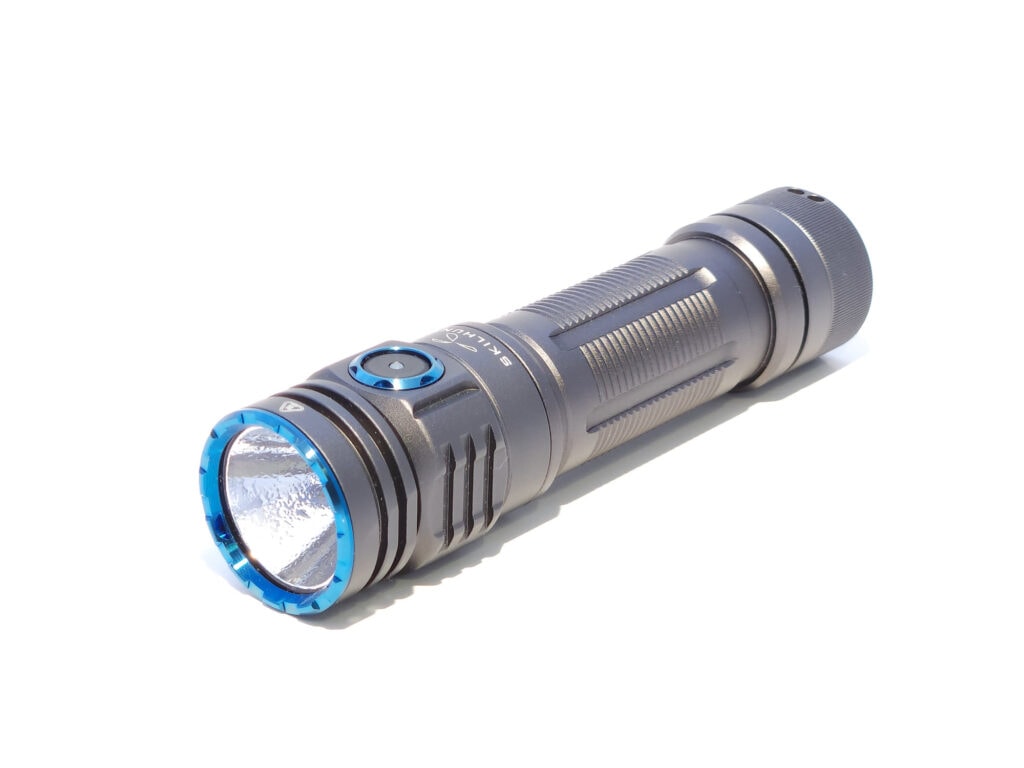
Skilhunt M300 v2 specs
| Brand & Model | Skilhunt M300 v2 |
|---|---|
| Flashlight category | EDC flashlight |
| LED | Nichia 144ART 4500K (as tested) |
| Max. output | 1900 lumens |
| Max. beam distance | 195 meters |
| Max. beam intensity | 9500 cd |
| Battery config. | 1*21700 |
| Onboard charging | Proprietary magnetic |
| Modes | 7 |
| Blinkies | Strobe, SOS, Beacon |
| Waterproof | IPX8 |
| Review publication date | May 2023 |
Review intro:
If you’re a fan of Skilhunt’s M150 v3 or M200 v3, then you already know what you’re in for. The M300 v2 is that, but bigger. Ok, that’s a little too much of a generalization, but it’s a good overview. I always wondered why Skilhunt made the M300 v1 an 18650 light when they already had an 18650 light in the M200, and so to me, upgrading the M300 v2 to be a 21700 light makes complete sense. Besides the battery, the other main difference between the M200 and M300 is that the M300 uses a 6V 5050 emitter instead of the 3V 3535 in the M200 and M150. So what else is different? Is anything else different? Let’s find out!
Package quality.
Skilhunt’s packaging always looks shelf-ready, and the M300 v2’s is no different. I appreciate that there’s a tab you can use to pull the tray out of the box, and that the light is cradled in a molded plastic insert, while the accessories are kept together in a cardboard box under it. It looks very professional.
Inside the box, you’ll find
- Skilhunt M300 v2
- Skilhunt BL-250 21700 battery (Optional)
- Clip
- Lanyard
- Plastic zip-top bag with spare o-rings
- Skilhunt MC-20 USB charging cable
- Instruction manual
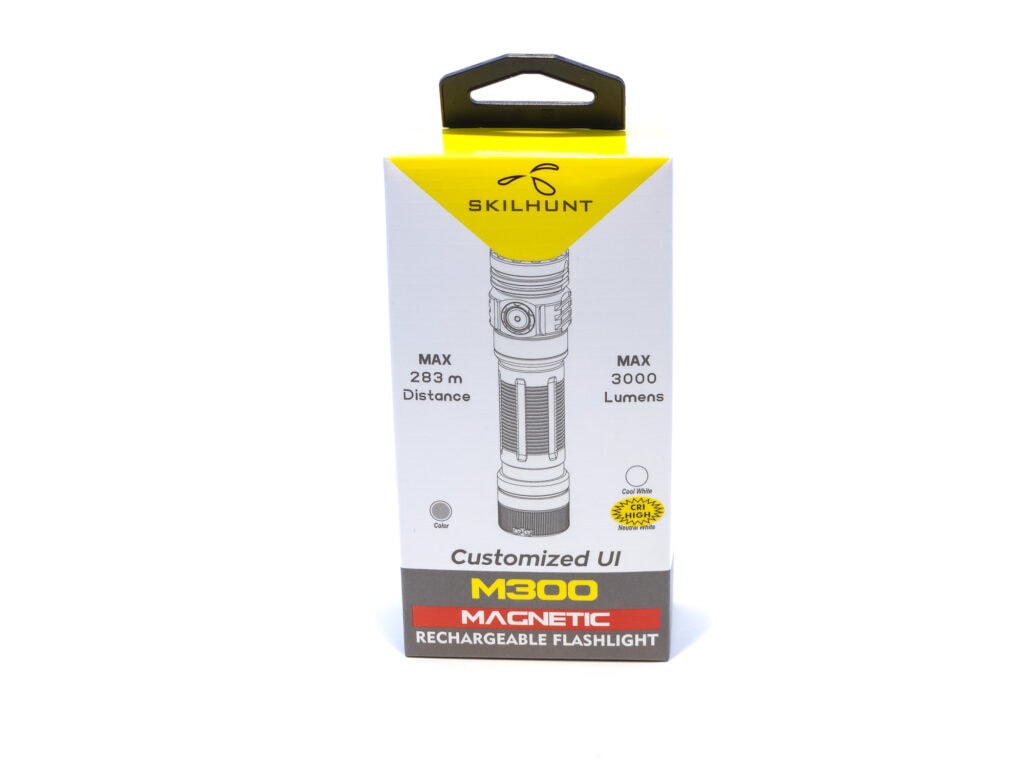
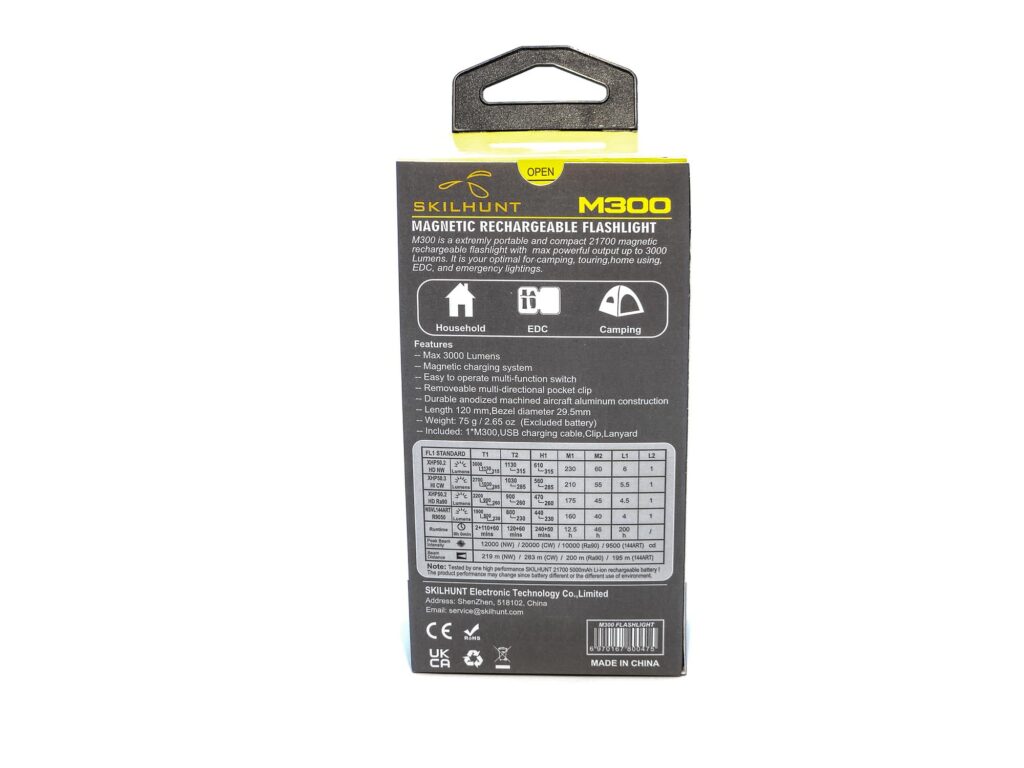
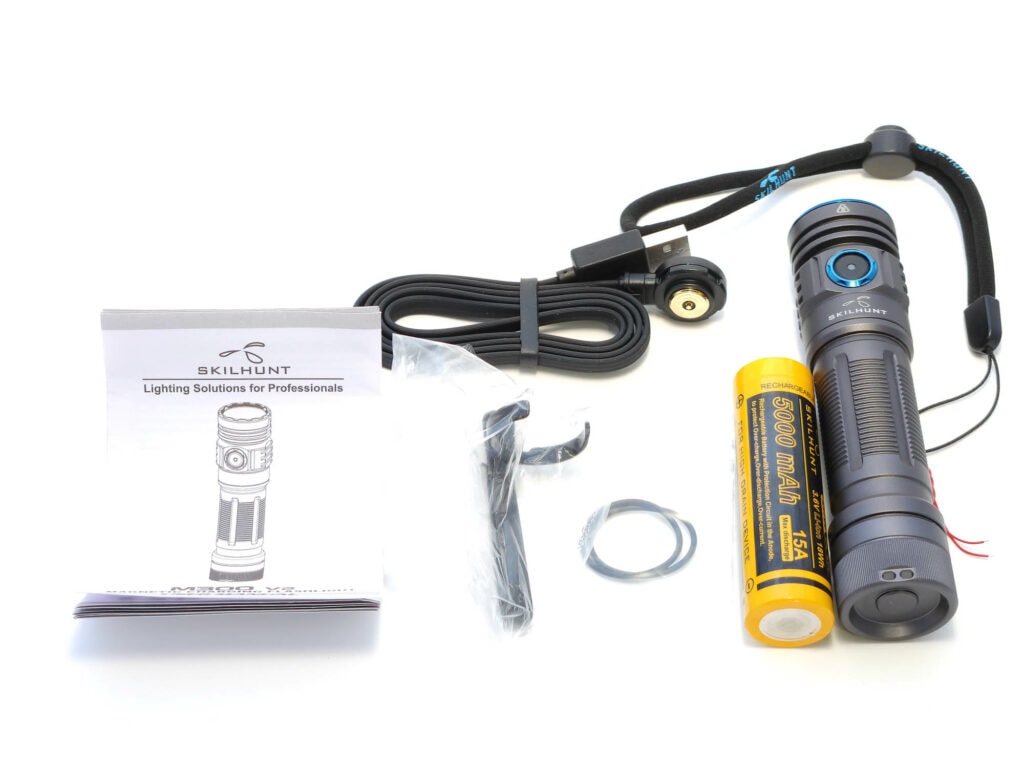
Flashlight in use
Like many 21700-sized lights, the M300 v2 fits nicely in my hand, with the electronic side switch falling right where my thumb is. The switch is recessed slightly from the lip of its bezel, about the same as with other M-series lights I own. This is slightly lower than previous generations, but can still be easily activated unintentionally.
Of course, hoping it doesn’t get turned on with an accidental bump isn’t enough, so there is electronic lockout, activated with 4 clicks from off. While it’s in lockout, the indicator light will blink red, though that can be toggled on or off with a double-click. Holding from off will allow you to activate momentary moonlight, a feature I always like, as it can be annoying to always have to lock and unlock a light, especially if you just need a small amount of light.
With the upgrade, Skilhunt standardized the UI to be the same as the M200 v3 and M150 v3, so you have easy access to what’s essentially: low, medium, and high. Hold from off to get into the low grouping, click for the main (medium and high) grouping, and double-click for the turbo grouping. (There’s also a strobe group which you can get to with a triple-click.) The new UI is still similar to their old 2 group programming UI, though there aren’t quite as many options. Some miss the old UI, but I feel like the new UI is a good upgrade. While in any group, you can hold the switch to cycle through the 2-3 different levels or modes within that group and that will be memorized, so there is still some customization, if you will.
With the M300 v2 going from 18650 to 21700, it loses some pocketability. It’s still a little smaller than many other 21700s, but it’s definitely bigger than before. This one is better for a jacket pocket or bag because of that. The bi-directional clip is similar to that of its smaller siblings, and holds well. It’s not completely deep carry, but still fairly deep, especially for a 21700. You can clip it onto a hat, but the weight of the 21700 might affect your usage compared to a smaller light.
The clip helps stop the light from rolling, but the M300 v2 also has a number of flat sections on the head which help keep it stable as well. The M300 v2 can tail stand easily, but it’s missing something that the smaller M-series lights have: A magnet in the tail cap. Could a magnet hold up a 21700 light? Sure, but there just isn’t one here.
Skilhunt’s lanyards have a spring-loaded cinch, so you can tighten against your wrist and it won’t slip off. I won the thread lottery, and my lanyard holes actually line up with the switch! Your mileage may vary. No matter where the lanyard holes in the tail cap fall, there’s two of them, so you can thread the lanyard through them and use it while not affecting the ability to tail stand.
Like the M200 v3 and M150 v3, the M300 v2 is a good choice for many tasks. Since it’s larger, it may not qualify as a pocket EDC, but it’d definitely be something I’d EDC in a bag. While plain USB-C charging would be more convenient than the proprietary magnetic charging Skilhunt’s M-series lights have, but at least you only have to bring one USB cable with you and not an external charger. Because of that, I feel like this would be a good light for travel. Of course it’s good for nightly walks or activities around the house or workplace, too. Whatever you’d like to use it for.
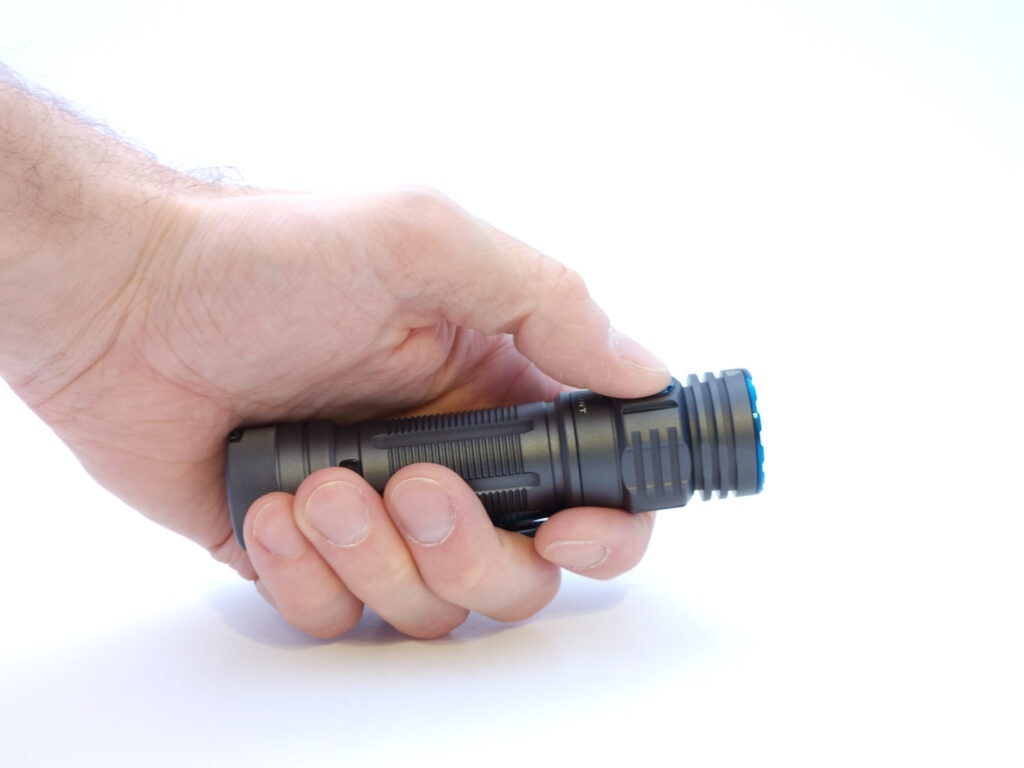
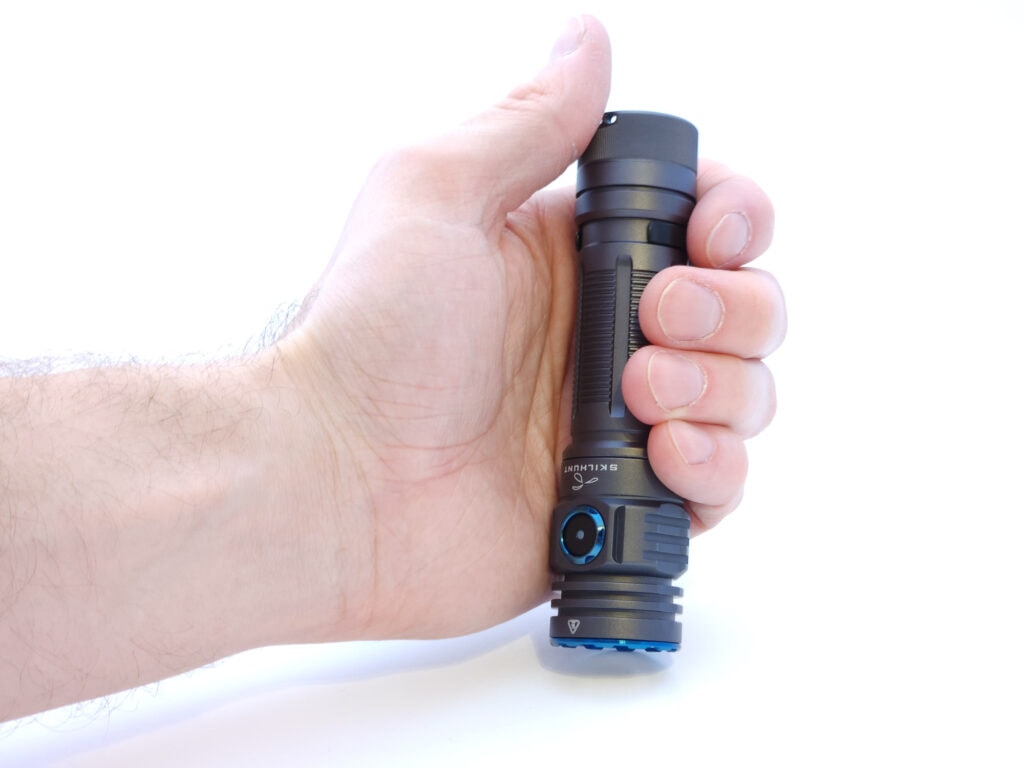
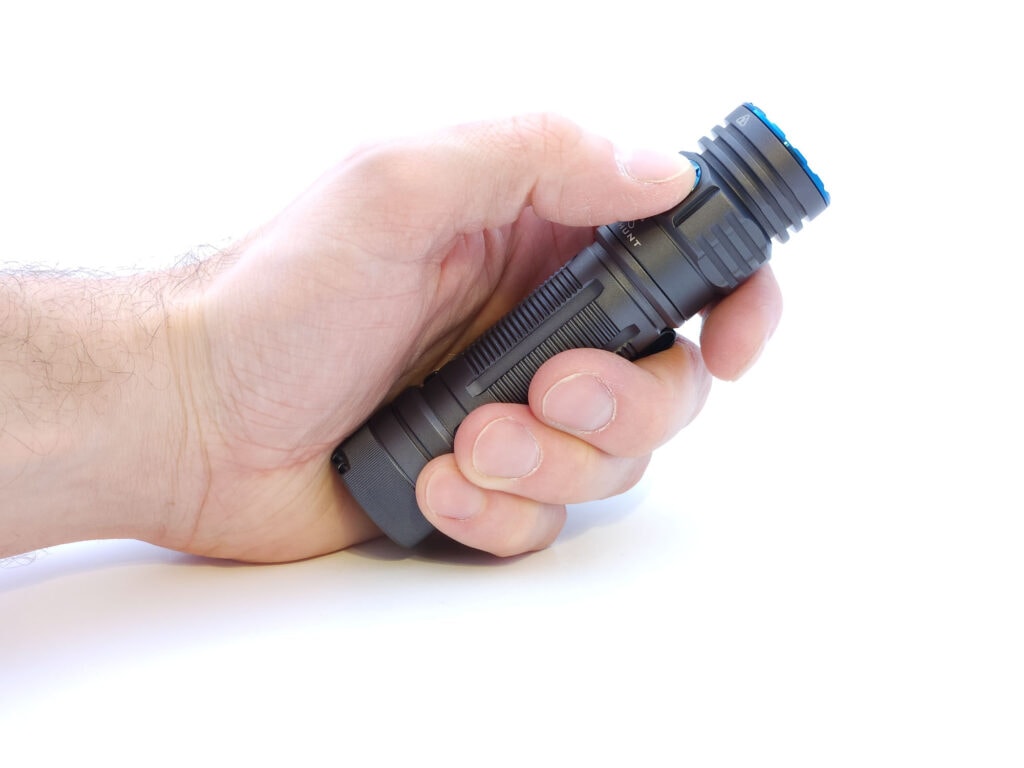
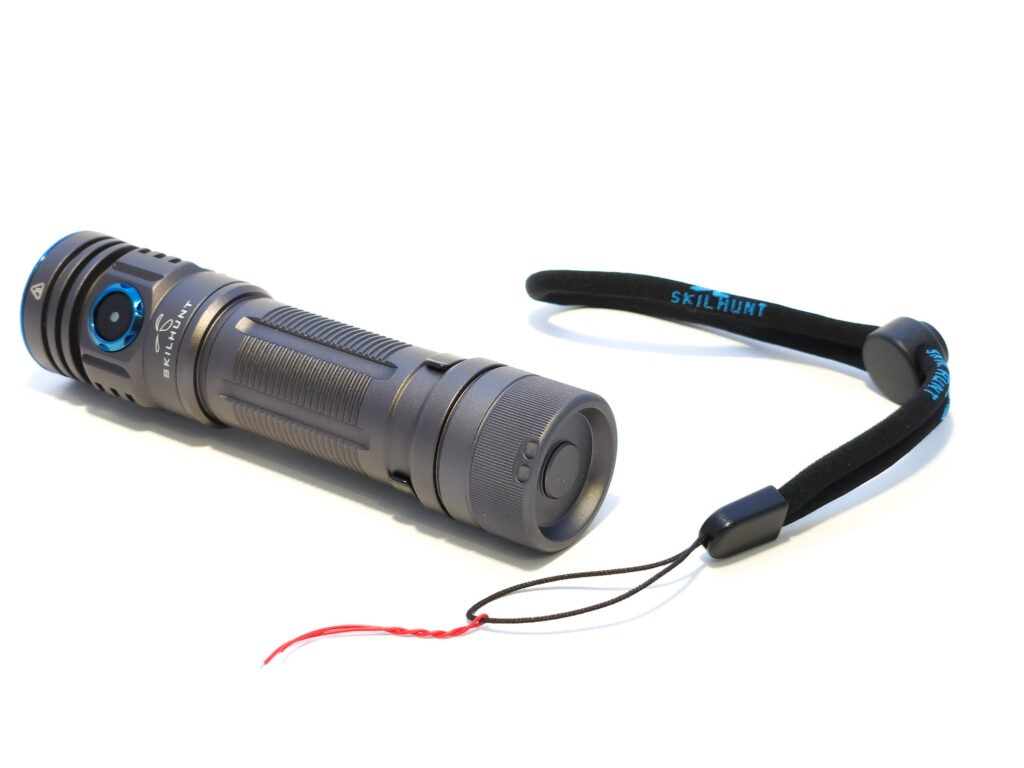
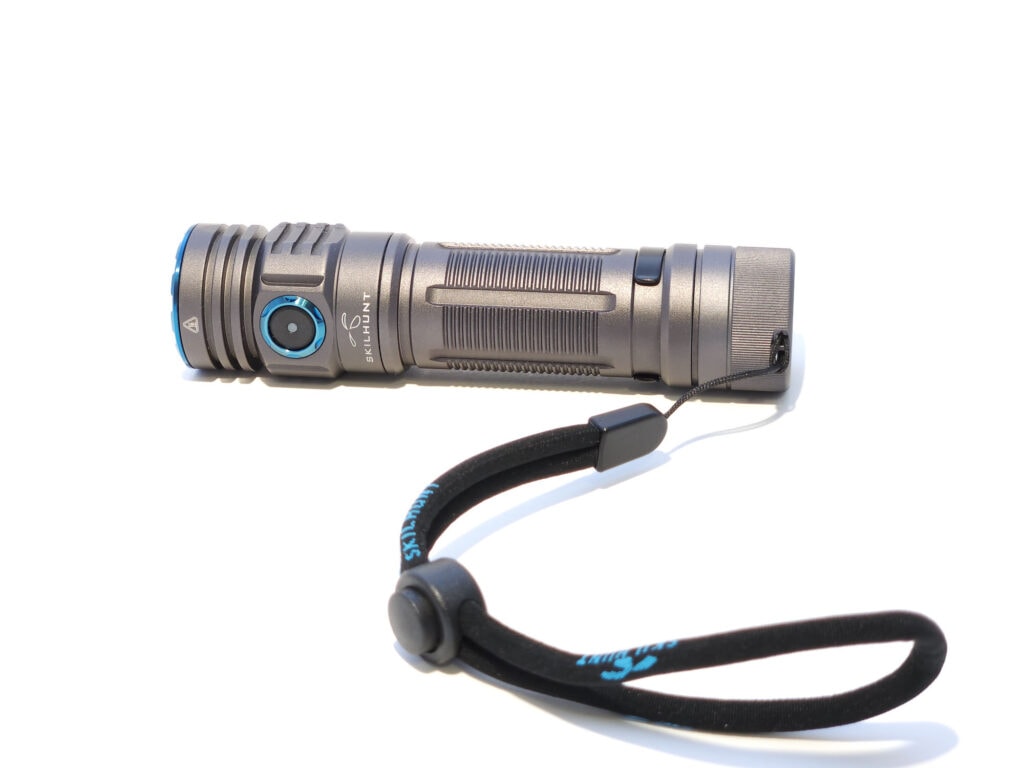
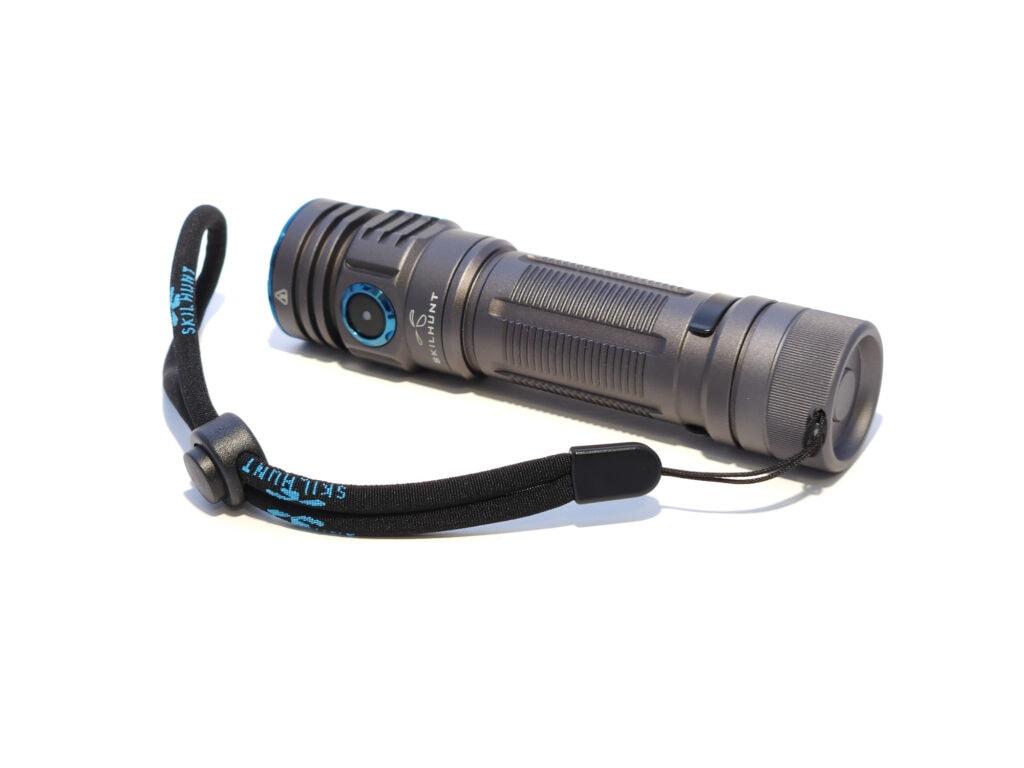
Build Quality and Warranty
If you’ve seen the M300 v1, then you’ve basically seen the M300 v2 as well; they look nearly the same! From the herringbone knurling on the tailcap, to the thick knurling on the body, all the way to the deep cooling fins of the head, and even the ever-so-slightly crenulated blue bezel, the M300 v2 is almost just a resize of the M300 v1. Maybe the biggest physical change besides the size is that there is no tail cap magnet in the M300 v2. This design is also very similar to the M200 v3, but the head and tail are actually proportionally larger on the M300 v2 than on the M200 v3.
Another change from v1 is that the only available color is gray anodized aluminum now instead of black, with blue accent bezels around the lens, switch, and charging port. The Skilhunt logo is displayed proudly front and center below the switch in fine laser etching opposite the M300 v2 markings and below a tiny “hot” warning symbol at the very top of the head, below the bezel.
The tail cap threads are fairly smooth and come lubed, and hide a sticker on the inside of the tube which shows the direction which the battery should go in, which is + first as normal.
The included battery is a little loose side to side but does not rattle unless you smack the light hard (which I advise against for obvious reasons). The springs on both ends of the tube hold it tightly in place.
The M300 v2 is covered by Skilhunt’s standard warranty. You can read the full text of it on their Service page.
To summarize:
- Free product replacement due to defect within 15 days of purchase
- Free product repair due to defect within 24 months of purchase
- Paid repair available after 24 months
- Warranty may not be honored if purchased from unauthorized dealer
- Warranty does not cover normal wear or non-defect damage
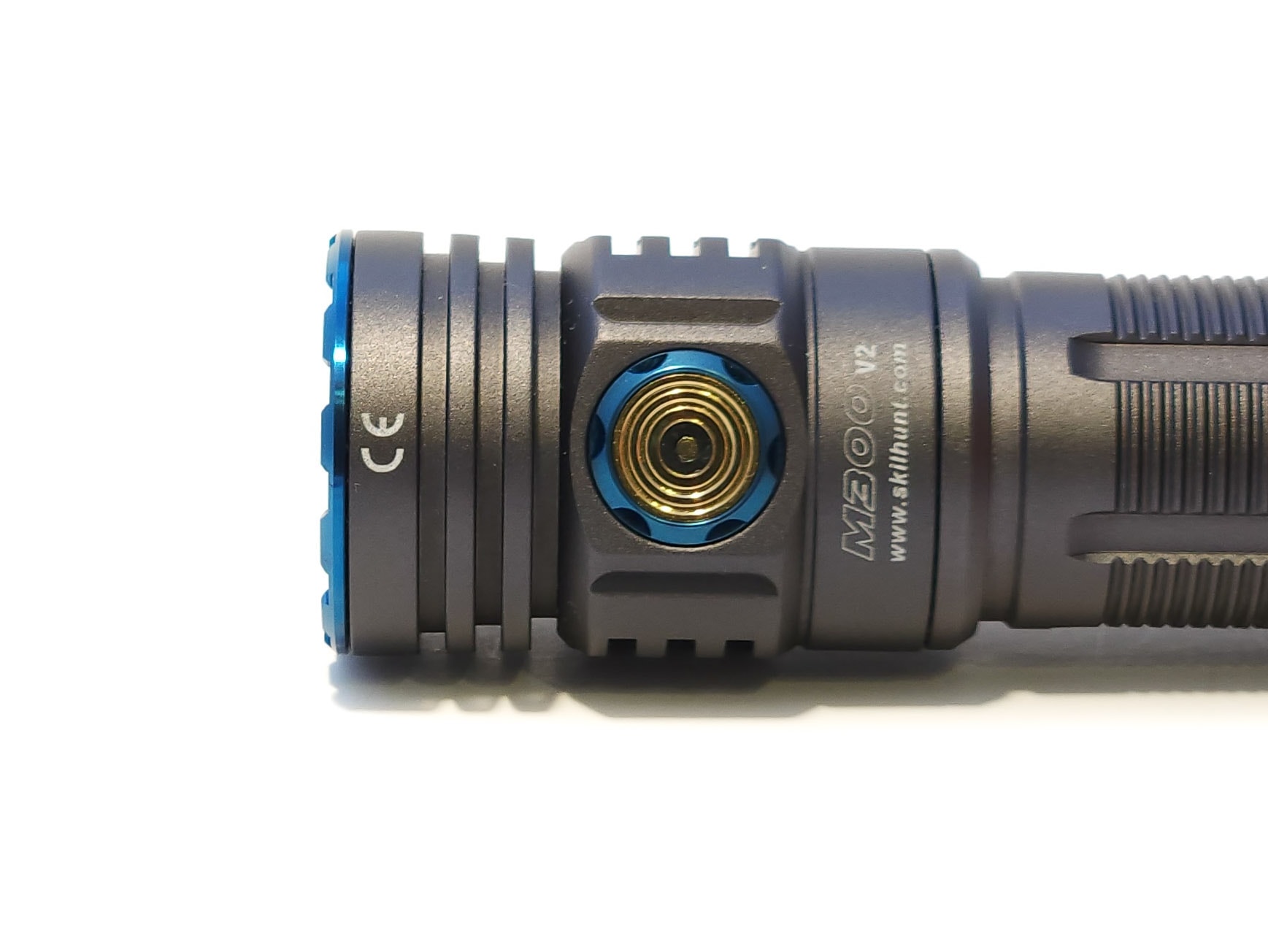
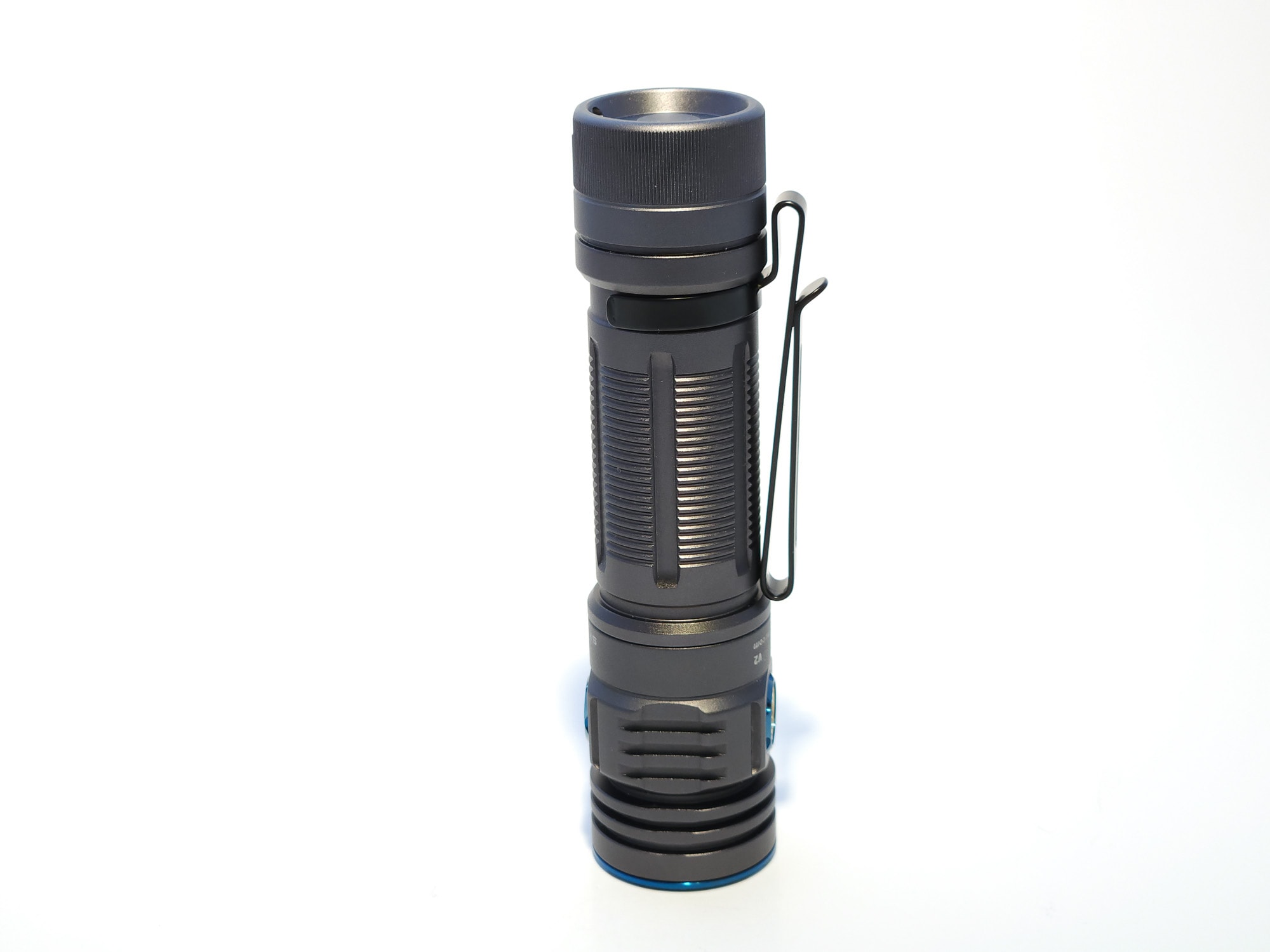

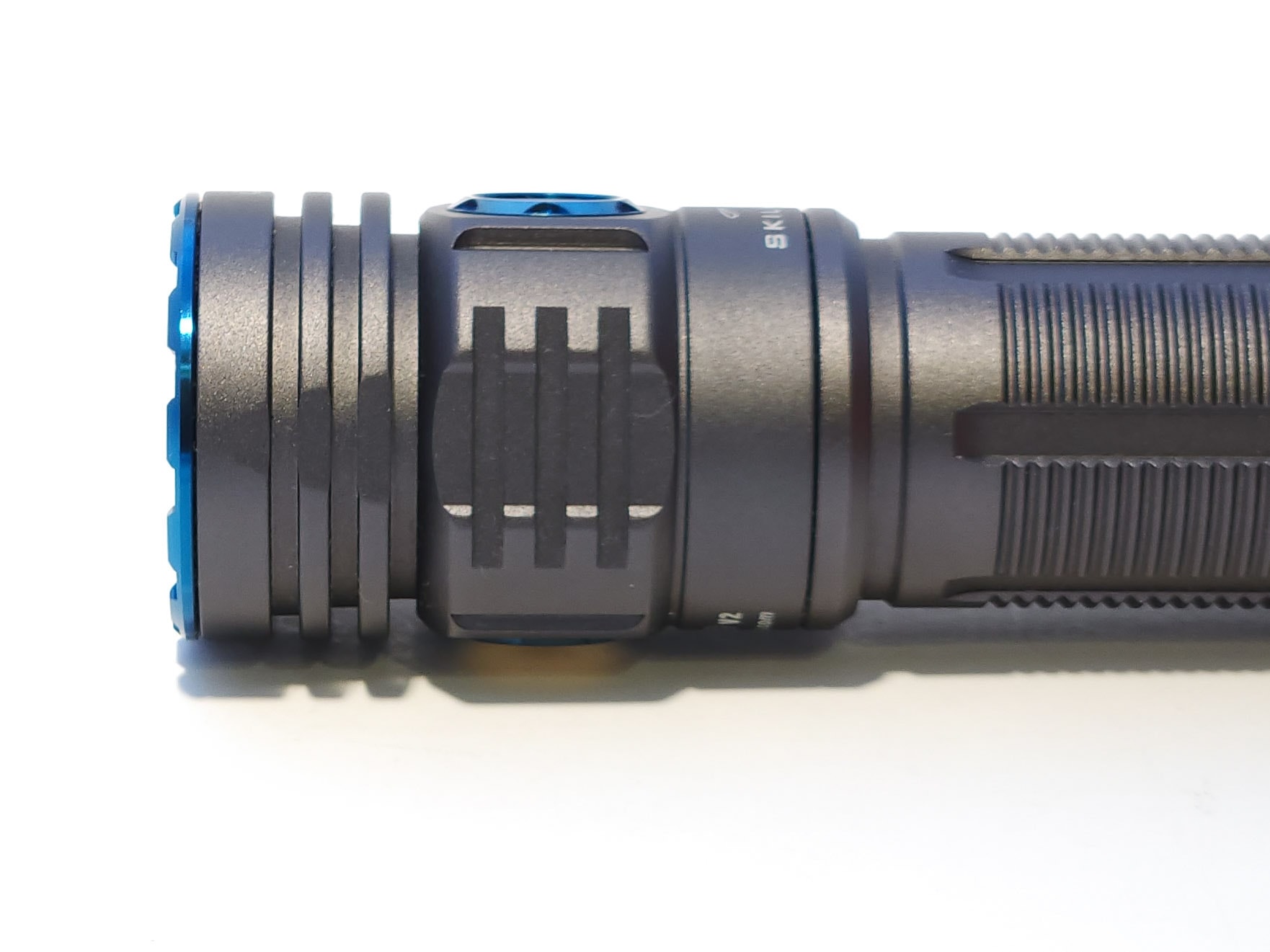
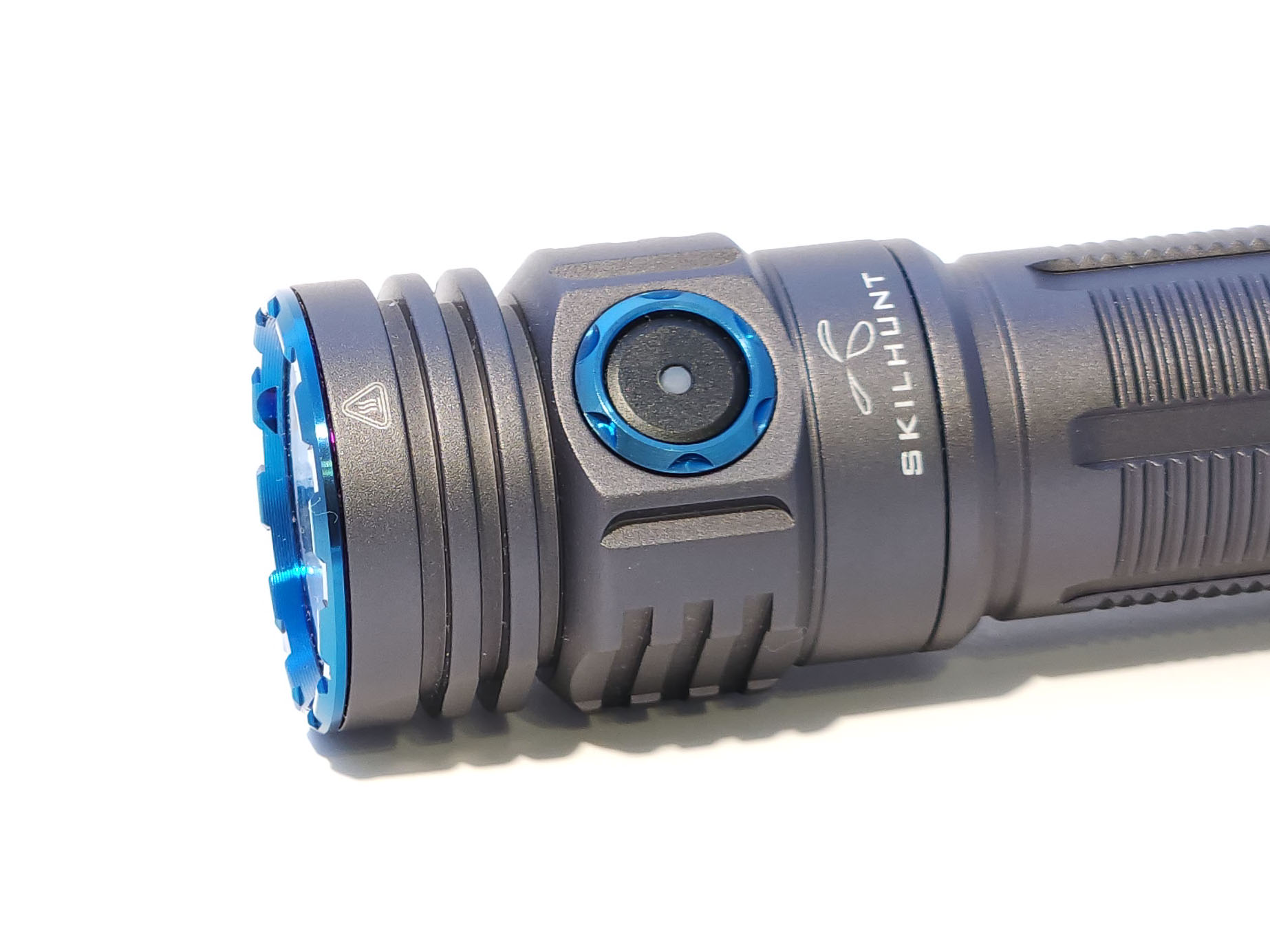
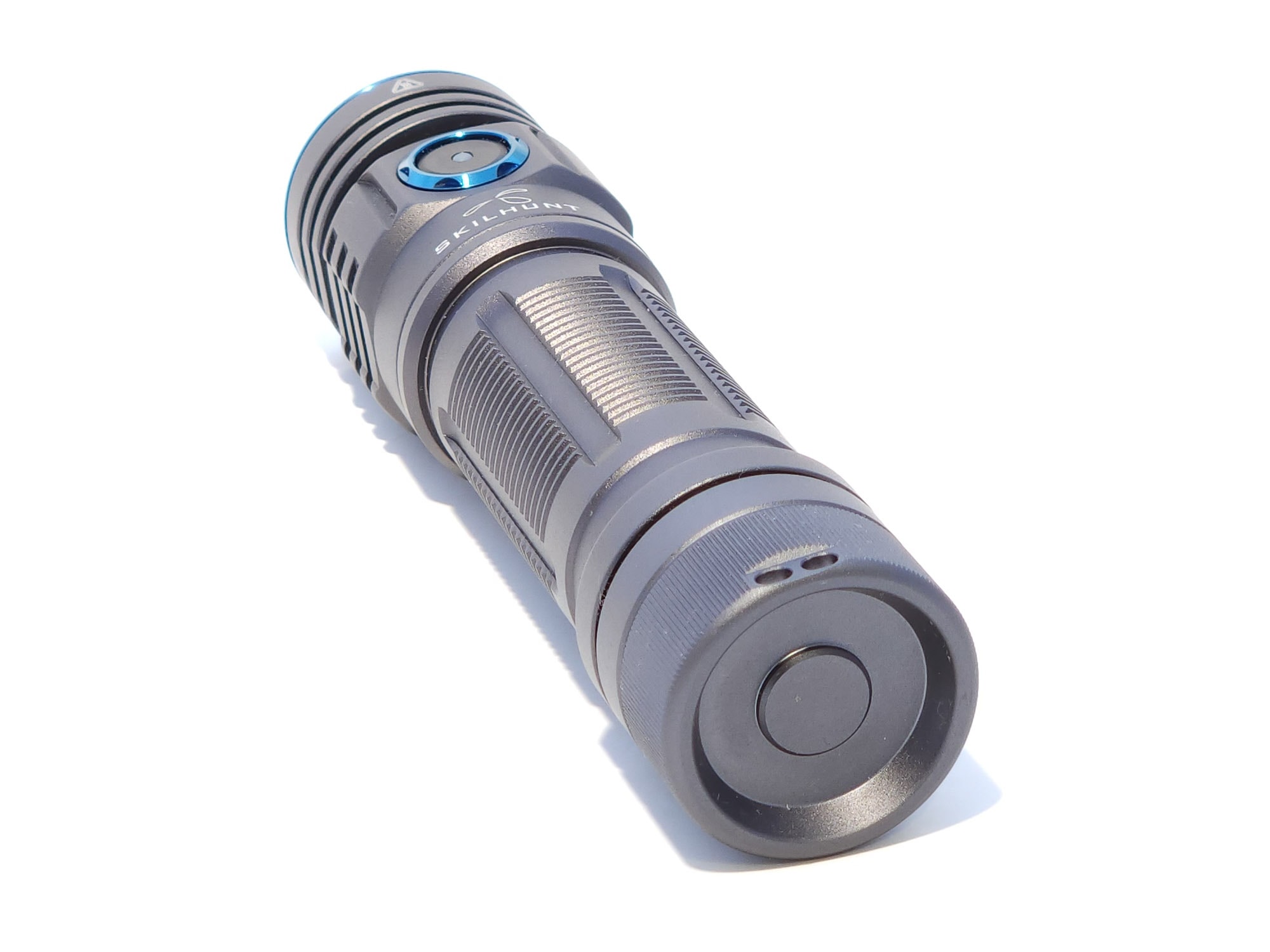
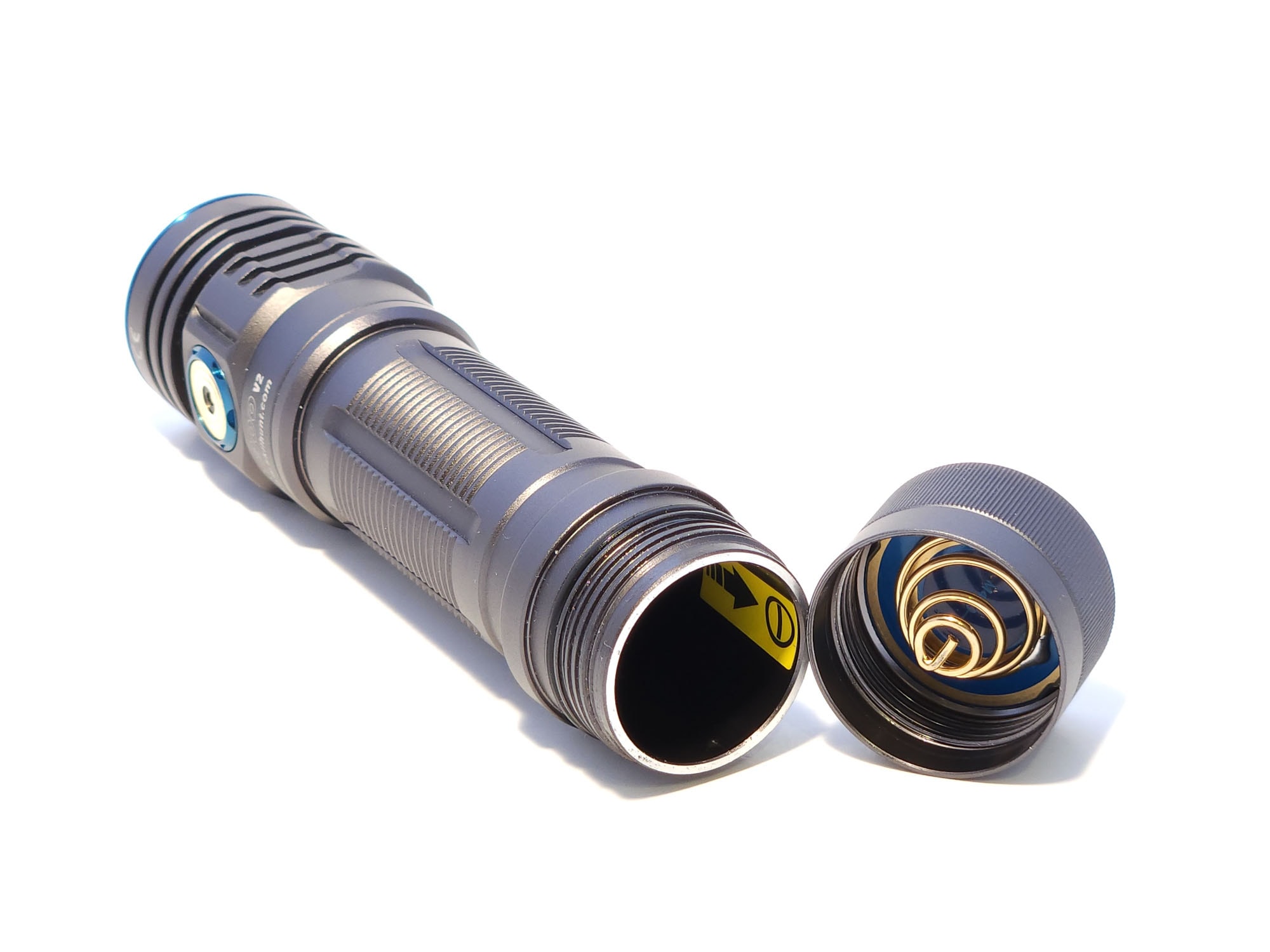
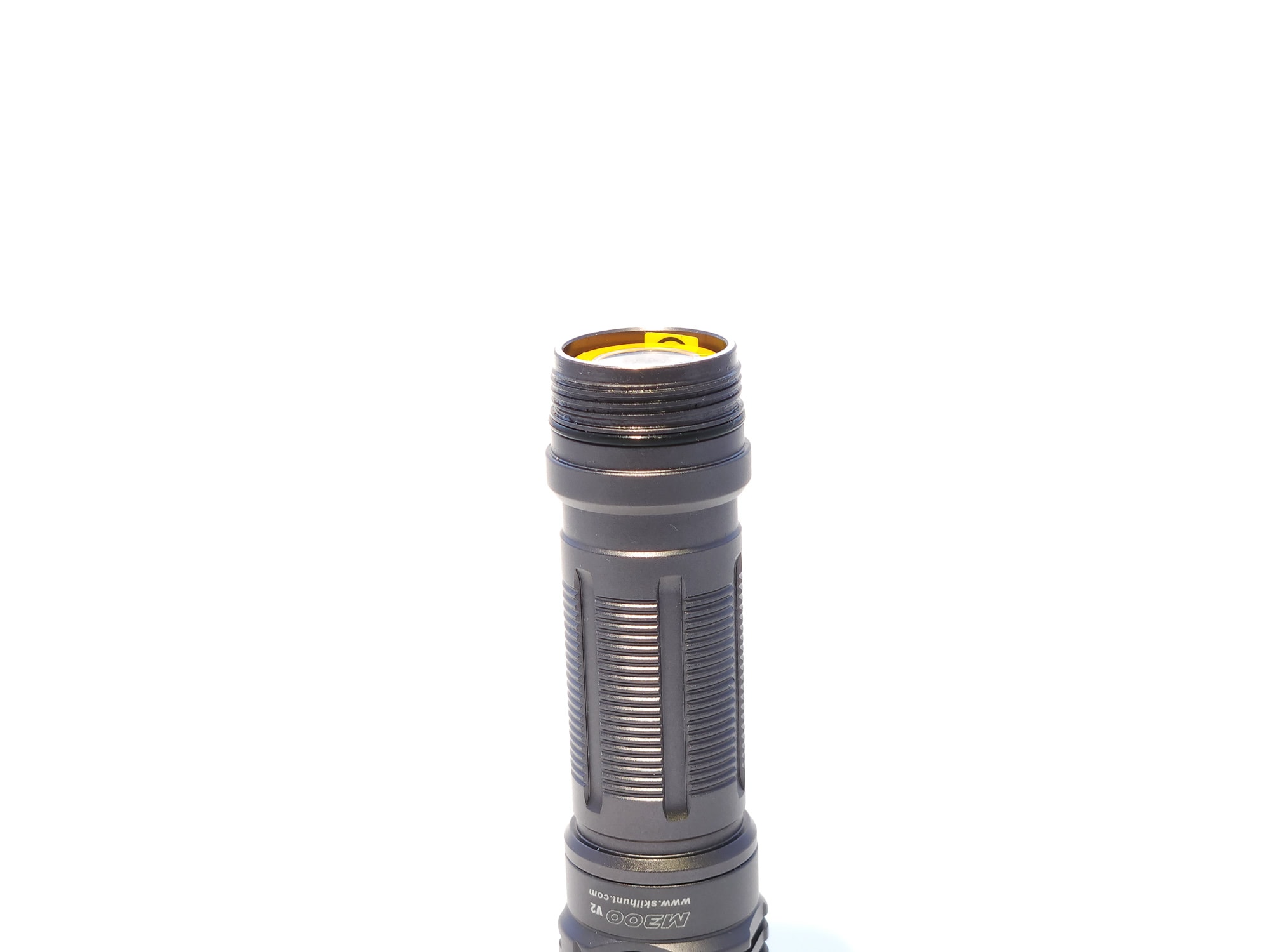
LED, Lens, Bezel, Beam, and Reflector
While the M300 v1 used an 18650 size battery, the same as the M200, the difference was that the M300 uses 5050-sized (5.0mm x 5.0mm), quad-die (essentially four smaller LEDs on one chip) emitters running a higher voltage (6V or 12V). The M300 v1 came with the Cree XHP35, either the HD (domed) or HI (domeless) version, but the M300 v2 comes with four emitter options. Copied from their site:
LED:
- CREE XHP50.3 HI Cool White 6500K
- CREE XHP50.2 HD Neutral White 5000K
- CREE XHP50.2 HD Ra90 High CRI 5000K
- Nichia 144ART R9050 4500K
Max output:
- CREE HD NW : ANSI 3000 Lumens
- CREE HI CW : ANSI 2700 Lumens
- CREE HD High CRI : ANSI 2200 Lumens
- Nichia High CRI: 1900 ANSI Lumens
Max beam distance:
- 219 meters(NW) / 283 meters (CW) / 200 meters (Ra90) / 195 meters (144ART)
Max peak beam intensity:
12000 cd (NW) / 20000 cd (CW) / 10000 cd (Ra90) / 9500 cd (144ART)
So what’s the difference? Why would you choose one over the others? Let’s go from the top.
XHP50.3 HI 6500K – Coolest CCT of the bunch, so it has the highest lumen output and being the HI (domeless) version of the XHP, it will also throw the farthest out of these options, but the quality of light (CRI, DUV) will be lower.
XHP50.2 HD 5000K – The lower CCT will lower lumen output, and the dome (HD) will decrease throw, but this neutral(ish) option still has good power. Quality will probably be on par with the XHP50.3 HI
XHP50.2 HD 5000K Ra90 High CRI – Same CCT as above, but the higher CRI will mean the colors of what you’re illuminating will be more true. Generating higher CRI light is less efficient though, so it has less output than its low CRI counterpart.
144ART R9050 4500K – With both lower CCT and higher CRI, this emitter will have the lowest output in terms of lumens and throw, but have some nice quality light.
So depending on your needs, you could select a high output option or one with a better quality light.
Whichever emitter you choose will be focused by an orange peel reflector, tucked in behind anti-reflective coated glass, and held in place by a lightly crenulated bezel. The bezel unscrews easily, so you could swap the emitter, provided you have one with the correct voltage.
My test light came with the Nichia 144ART, so keep that in mind as you look through these readings.
The measurements from my Opple Light Master Pro were very consistent across modes. DUV is slightly above BBL, giving it a slightly yellow-green tint. I found this unusual from Nichia, being used to the 519a and 219b which consistently have a more rosy tint. It’s not bad, just keep that in mind if you haven’t used a 144ART before.
| Mode | CCT | CRI | DUV | Flicker |
|---|---|---|---|---|
| L2 | 4265K | 94.1 | 0.0037 | 947 Hz |
| L1 | 4249K | 93.9 | 0.0041 | 5500 Hz |
| M2 | 4263K | 93.6 | 0.0044 | 10038 Hz |
| M1 | 4296K | 93.3 | 0.0044 | 10077 Hz |
| H1 | 4301K | 93.3 | 0.0034 | 30281 Hz |
| T2 | 4360K | 92.1 | 0.0044 | 29955 Hz |
| T1 | 4449K | 92.0 | 0.0013 | 24900 Hz |
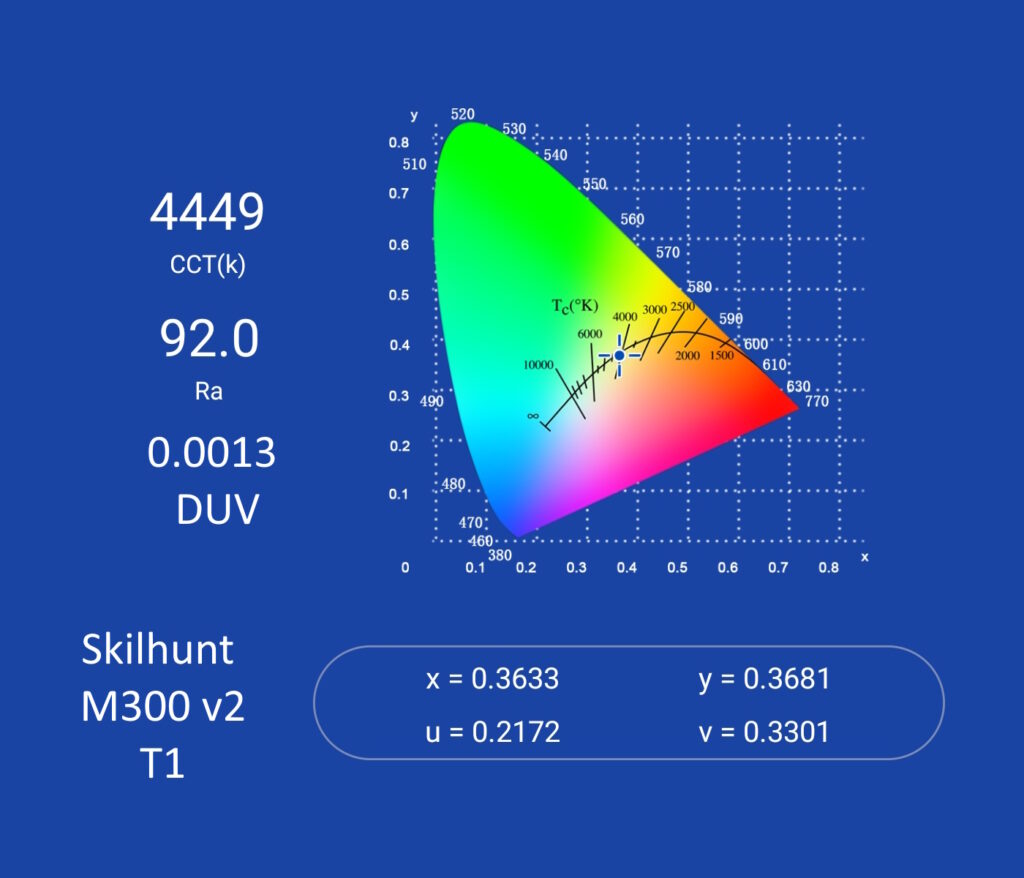
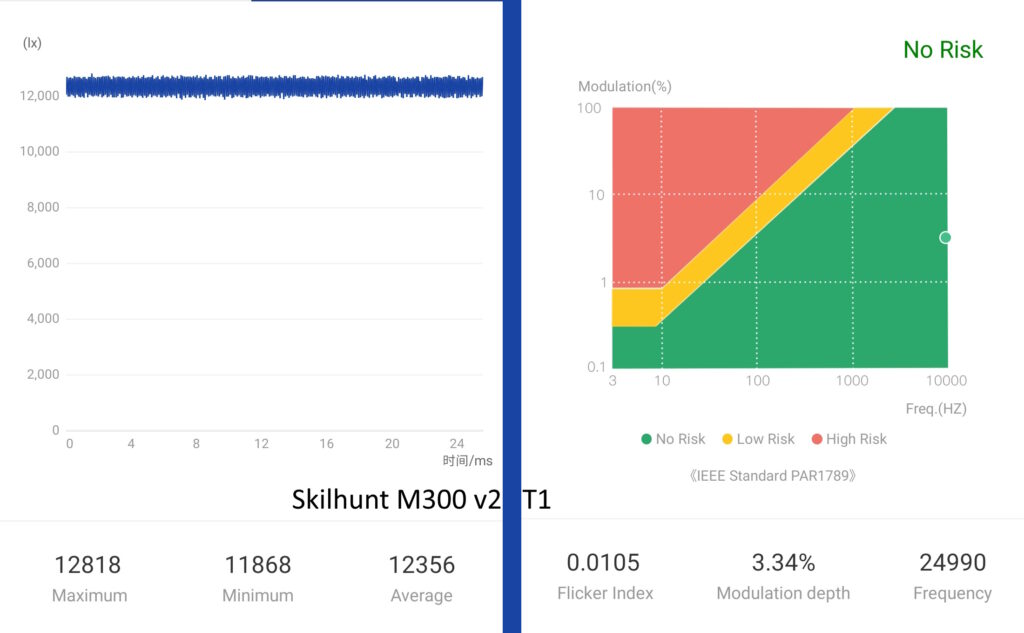
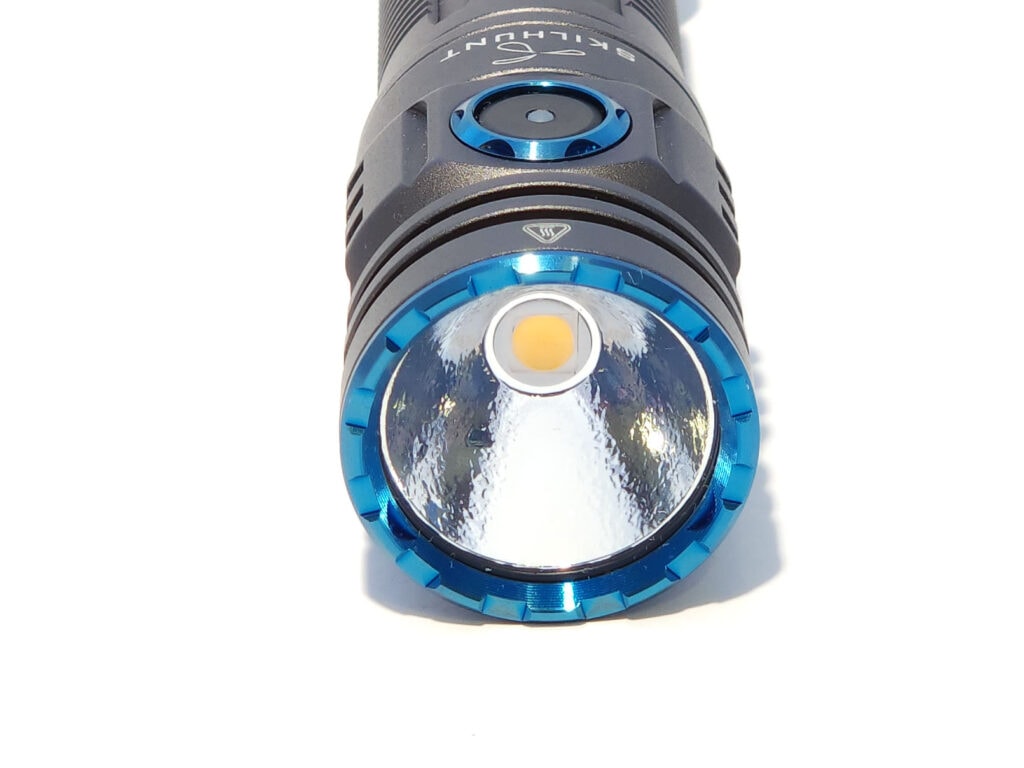
Dimensions and its competition
Dimensions:
| Skilhunt M300 v2 | Millimeters | Inches |
|---|---|---|
| Length | 120 mm | 4.7 in |
| Head diameter | 30 mm | 1.2 in |
| Body diameter | 24 mm | 1.0 in |
Dimensions are rounded to the nearest millimeter, and to the nearest tenth of an Inch.
Weight:
| Skilhunt M300 v2 | Weight in grams | Weight in oz |
|---|---|---|
| Without battery: | 83 g | 2.9 oz |
| With battery | 156 g | 5.5 oz |
Weight is rounded to the nearest gram, and to the nearest tenth of an Oz.
Flashlight size comparison with its competition:
Group 1: Skilhunt M300 v2, Skilhunt M200 v3, Skilhunt M150 v2. You can see the family resemblance!
Group 2: Emisar D4V2, Skilhunt M300 v2, Convoy S2+
Group 3: Acebeam E70, Skilhunt M300 v2, Nitecore P23i
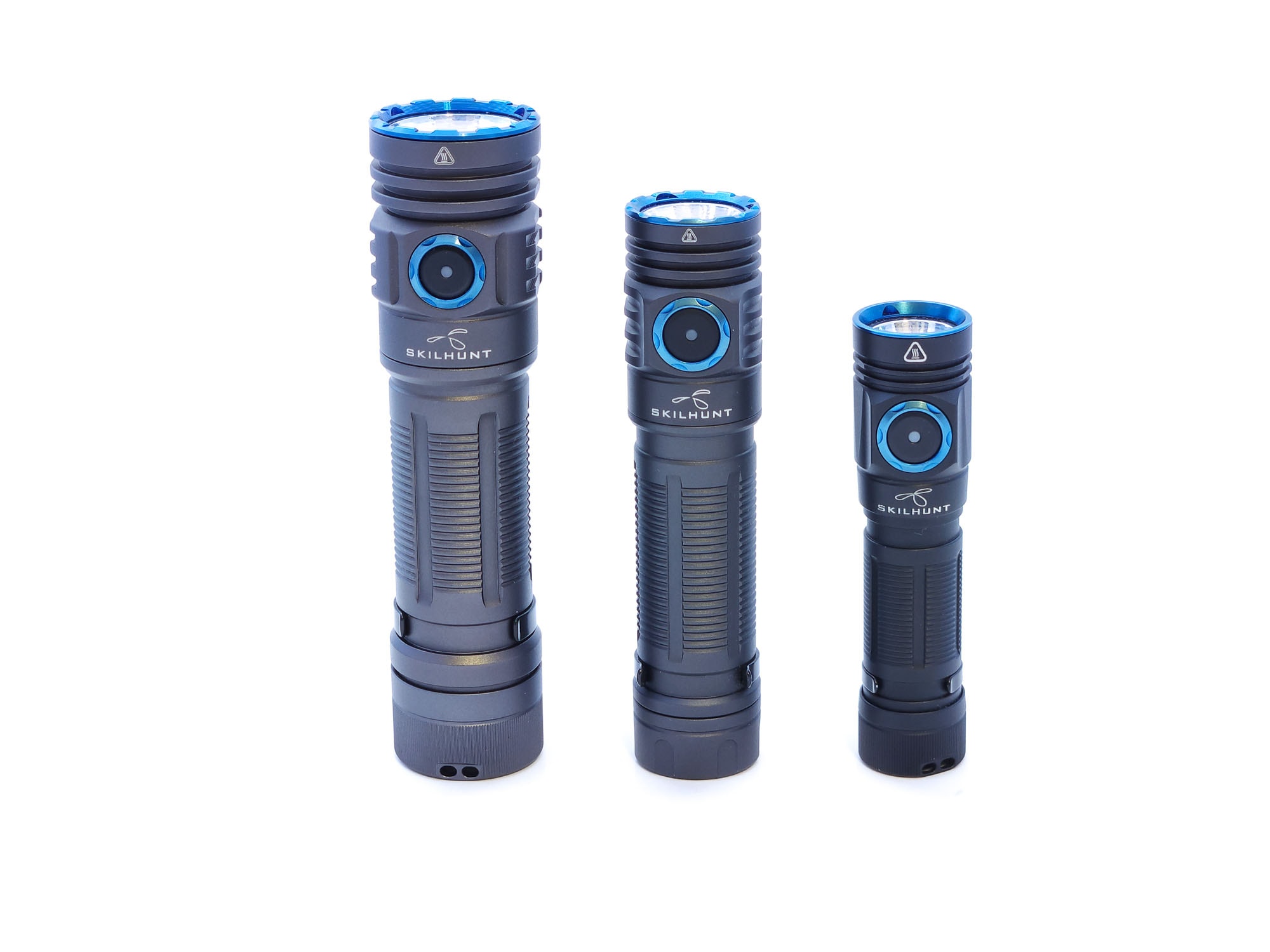
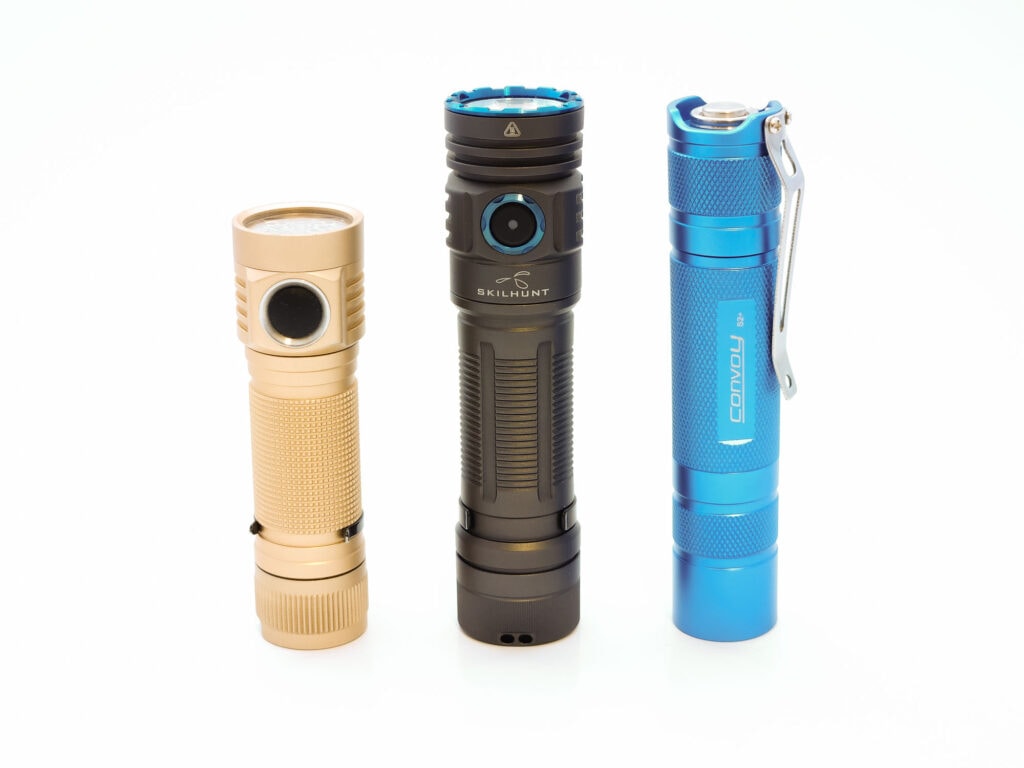
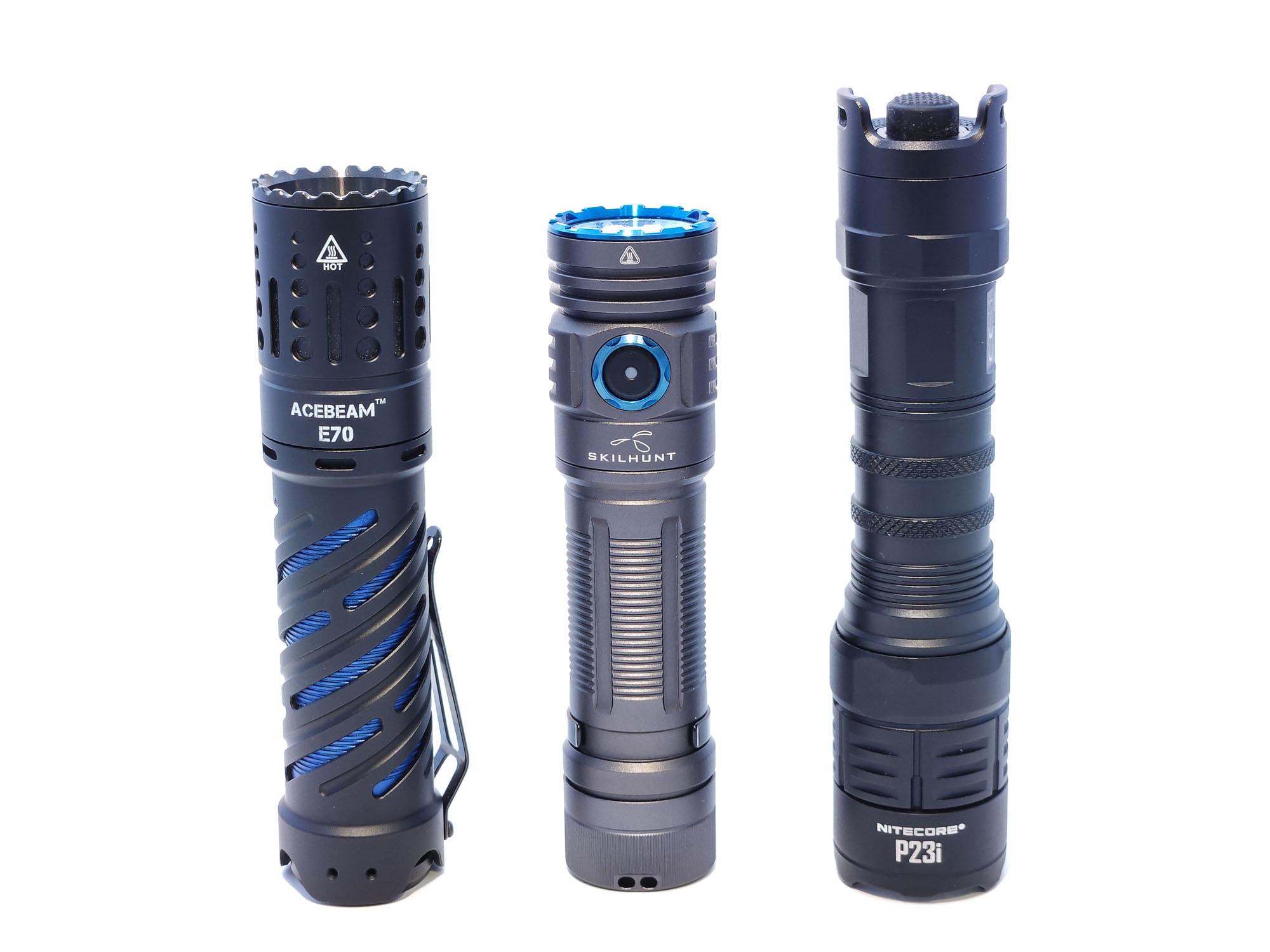
Skilhunt M300 v2 UI: User Interface and Driver
The M300 v2 shares a UI with the M200 v3 and M150 v3, replacing the 2 mode group UI of the previous generation.
Available modes:
- L2, L1, M2, M1, H1, T2, T1
Available blinky modes:
- Strobe, SOS, beacon
From OFF:
- Press and hold: Memorized low mode: L2 or L1
- Single click: Memorized regular mode: M2, M1, or H1
- Double click: Memorized turbo mode: T2 or T1
- 3 clicks: Memorized strobe mode
- 4 clicks: Lockout
From ON:
- Press and hold: Cycle next level within the same mode (except strobe)
- 1 click: Off
- Double click: Memorized turbo level (except from low mode)
- 3 clicks: Memorized strobe mode
Mode memory:
- Each of the modes retains its level
Shortcuts:
- To Low: Hold from off
- To Turbo: Double-click from off or regular mode
- To Strobe: Triple-click from off or regular mode
Low voltage warning:
- When the battery is getting low, the indicator light on the switch blinks red, and the emitter will blink twice every two seconds
Strobe/blinkies
- Triple-click to get into strobe mode
- Double click to cycle through strobes
- Strobes
- Strobe
- SOS
- Beacon
Lock-out mode:
- Electronic lockout is possible with 4 clicks from off
- When in electronic lockout, you can hold for momentary moonlight (L2)
- Physical lockout is also possible by unscrewing the tail cap
- Double-click in lockout to enable the locator beacon in the indicator light
PWM
- Not visible to me by eye or on my phone’s camera.
Skilhunt M300 v2 Charging and batteries
When purchasing the M300 v2 from Skilhunt, you have the option of including a battery, which is their 5000mAh 21700, the BL-250. This is a button-top, protected battery, but any 21700 should work, as long as it’s not too much longer than this one (74mm), since the springs inside the tube will help make contact, but they’re also very compressed with the BL-250.
Usually I advocate for buying the included battery if it’s offered for a few reasons: That practice can help keep the number of lights and batteries you own in sync; it’s more convenient than having to place a separate order for batteries; and you know you’re getting one that’s compatible with the light. As of this writing however, the cost of adding the BL-250 to the purchase of the M300 v2 is an additional $13, which is on the high side for a battery. A 21700 can be had for $10 or even $5, so just something to think about.
Skilhunt includes their MC-20 with the M300 v2. This is a magnetic charger which operates at 2A (see how they got the name?) by sticking to the charging port on the back side of the head, opposite the button and includes a tiny indicator light which is red while charging and turns blue when complete. The thing that makes this somewhat controversial is that it’s a proprietary port. Many people prefer USB-C charging, since those cables are pretty ubiquitous now, but if you have a number of Skilhunt lights, you’ll have as many cables as you do lights, so you can stash them at home or work or the car or wherever you need to charge your light. The only problem I foresee would be if this is your only Skilhunt light and you don’t have an external charger and you lose your cable, or it breaks. Then you’d be stuck, but even so, you can get a single bay Li-Ion charger for cheap.
The M300 has low voltage protection on the driver, and it kicks in around 2.9V. Charging took on average 4 hours, which seems a bit long for 2A and a 5000mAh battery, and terminated around 4.13V. Incidentally, you can use the light on any mode while charging. Plugged in without the battery, you can use any mode but turbo.
Using my Vapcell S4+ charger, I performed a 250mA capacity test on the BL-250, and it recorded a capacity of 5019mAh, so the battery specs are pretty on the mark.
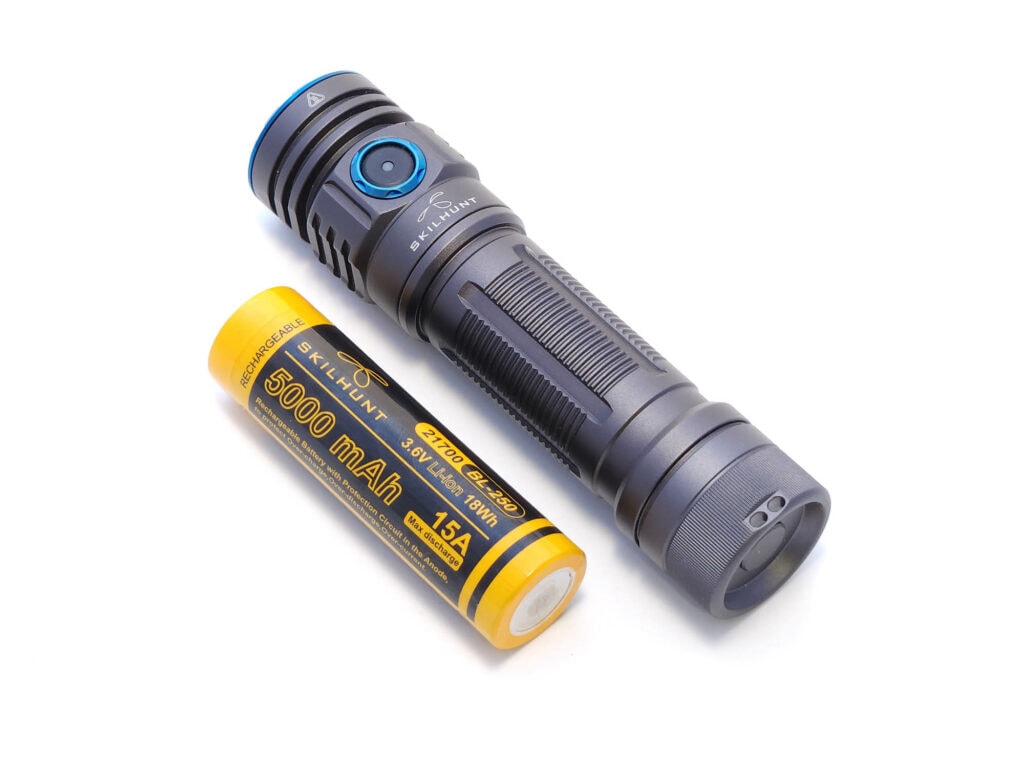
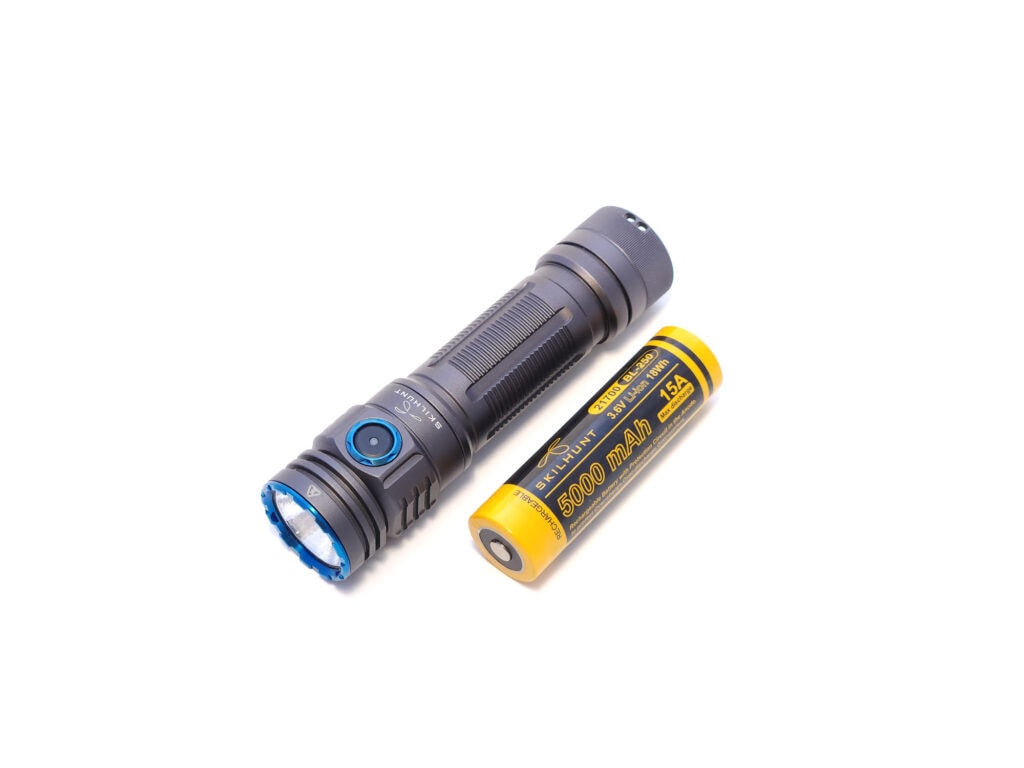
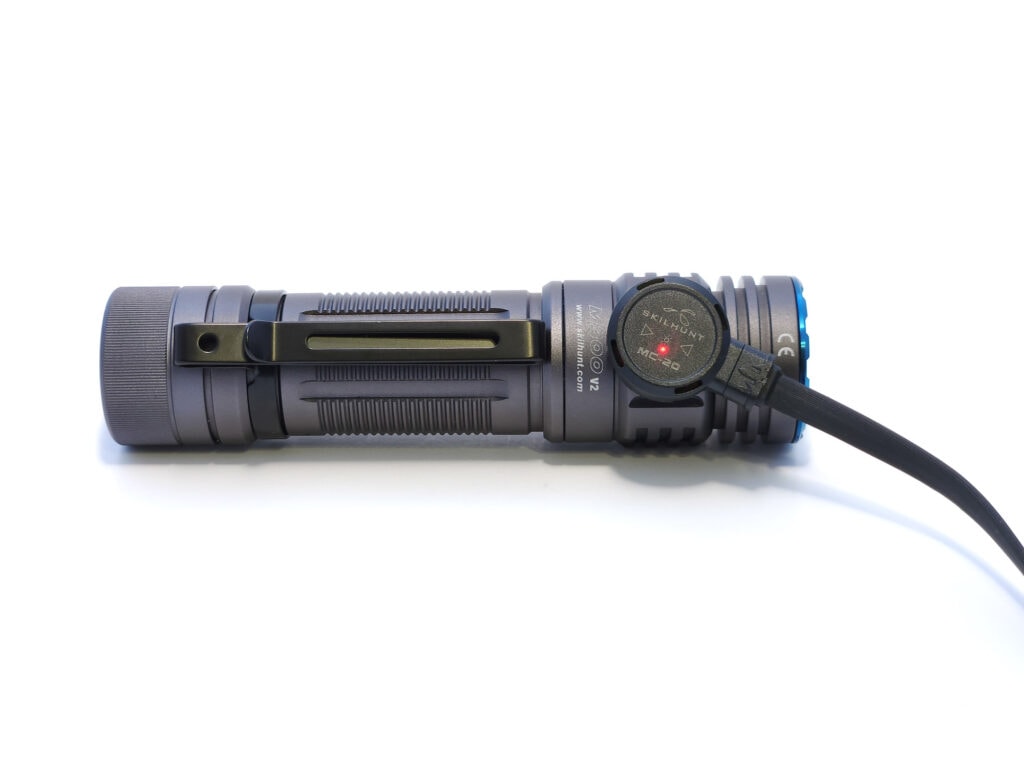
Performance test
Lumen measurements
How Lumens are Measured: Understanding ANSI FL1 Standards How Lumens are Measured: Understanding ANSI FL1 Standards: The ANSI FL1 standards specify that output in lumens should be measured 30 seconds after turning on, as this is the standardized time for measuring brightness according to the industry standard. This is why we focus on this part in our measurements. The ANSI FL1 standards require an ambient temperature of 22 ± 3°C. We record the ambient the ambient temperature to identify potential reasons for any observed discrepancies.To obtain these numbers, I used a very rudimentary integrated shoebox and ceilingbounce on my Samsung Galaxy S10. Measurements have been calibrated using a standardized calibration light provided by 1Lumen.
Before we go any further, it’s important to note that the M300 v2 comes with 4 different options for emitters, and the light sent to me for testing is using the one with the lowest output, the Nichia 144ART.
| Mode | Amps at turn on | Specified | turn on | 30 sec | 10 minutes |
|---|---|---|---|---|---|
| L2 | 0.01 | 1 | 0 lm | 0 lm | 0 lm |
| L1 | 0.02 | 4 | 3 lm | 3 lm | 3 lm |
| M2 | 0.10 | 40 | 43 lm | 43 lm | 42 lm |
| M1 | 0.42 | 160 | 165 lm | 165 lm | 164 lm |
| H1 | 1.25 | 440/230 | 437 lm | 433 lm | 426 lm |
| T2 | 1.81 | 800/230 | 762 lm | 759 lm | 731 lm |
| T1 | – | 1900/800/230 | 1670 lm | 1560 lm | 653 lm |
| Turbo at 3.6V | – | – | 1051 lm | 833 lm | 594 lm |
Amps were measured with a Cen-Tech digital multimeter to the best of my ability, as the fuse in my Klein Tools MM300 blew.
Parasitic drain:
- Skilhunt says the quiescent drain is 25 μA, though I could not measure any.
Skilhunt M300 v2 Battery Life: Runtime graphs
How Runtimes are Measured: Understanding ANSI FL1 Standards About ANSI FL1 runtime standards: The runtime is measured until the light drops to 10% of its initial output (30 seconds after turning on). This does not mean that the flashlight is not usable anymore. The last column shows how long the light actually works till it shuts off. If there is a + symbol, it means that the test was stopped at that particular point, but the light was actually still running. This happens on certain occasions, with certain drivers, firmware, or batteries.Runtime was a little shorter than specs on most modes, but I’d call it pretty close. I didn’t measure the lower modes, as their runtime is so long.
| Mode | Specified | Measured runtime ANSI | Time till shut off |
|---|---|---|---|
| L2 | – | – | – |
| L1 | 200h | – | – |
| M2 | 46h | – | – |
| M1 | 12h 30min | 12h | 12h |
| H1 | 4h 50min | 4h 25min | 4h 25min |
| T2 | 3h | 3h 02min | 3h 02min |
| T1 | 2h 52min | 2h 31min | 2h 31min |
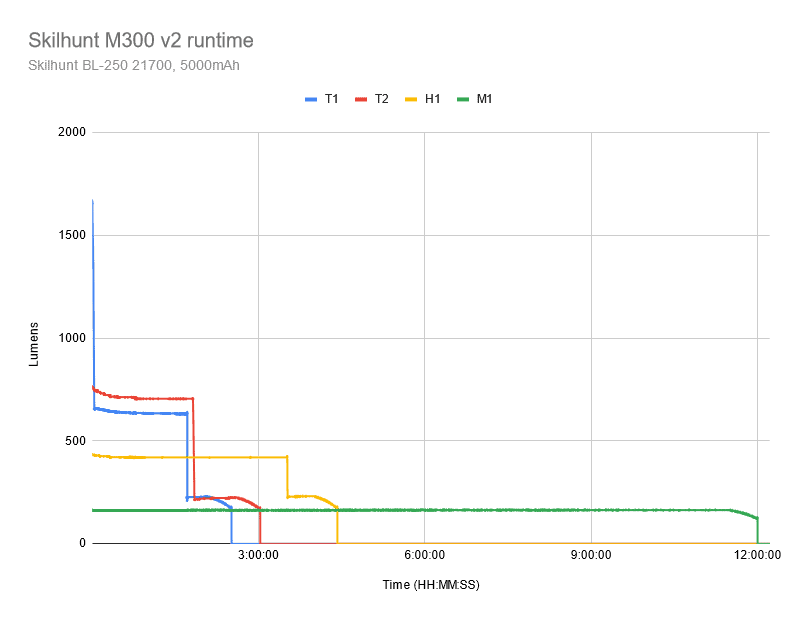
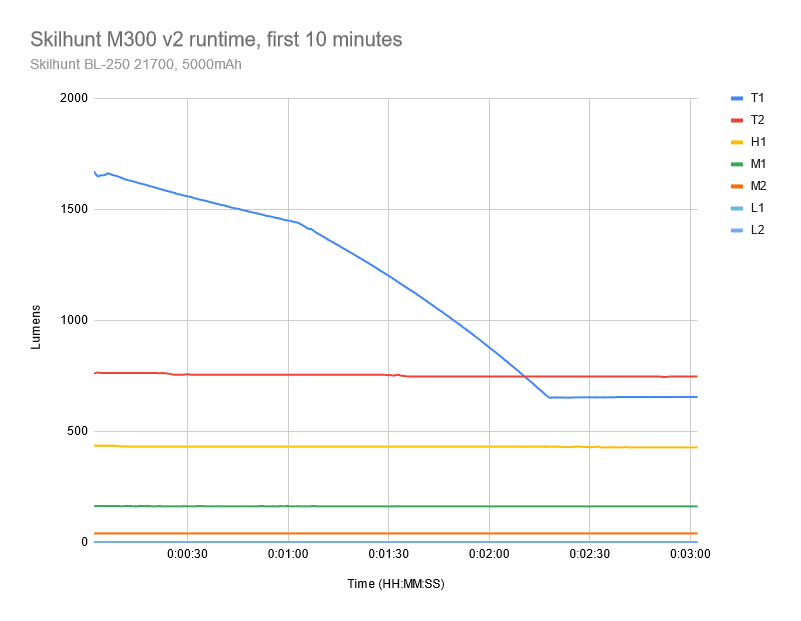
Peak beam intensity and beam distance measurements
About Peak beam intensity: Understanding ANSI FL1 Standards About peak beam intensity The calculated value of distance in meters at which the flashlight produces a light intensity of 0.25 lux. (0.25 lux is about the brightness of a full moon shining on an object). This means that the intensity has decreased so much, it becomes difficult to see darker objects, or objects that don’t reflect light. The columns ‘Meters’ and ‘Yards’ use rounded numbers.The numbers for candela were obtained with a UNI-T UT383S luxmeter at 5 and 15 meters, then averaged.
Throw on the M300 v2 is pretty spot on, according to my calculations.
| Mode | Specified | Candela measured | Meters | Yards |
|---|---|---|---|---|
| L2 | – | – | – | – |
| L1 | – | – | – | – |
| M2 | – | 188 cd | 27 m | 30 yd |
| M1 | – | 576 cd | 48 m | 52 yd |
| H1 | – | 1963 cd | 89 m | 97 yd |
| T2 | – | 3843 cd | 124 m | 135 yd |
| T1 | 9500 cd | 9529 cd | 195 m | 213 yd |
Beamshots
These were taken with a Samsung Galaxy S22+ using pro mode and the following settings:
- WB 5000K
- ISO 200
- Speed 0.5
Distance to the other end of the playing field is 100 meters.
The M300 v2 certainly puts out a lot of light, even the 144ART version, which has the lowest output of all!
Beamshots of the following flashlights compared:
- Skilhunt M200 v3
- Mateminco FW3s
- ThruNite TT20
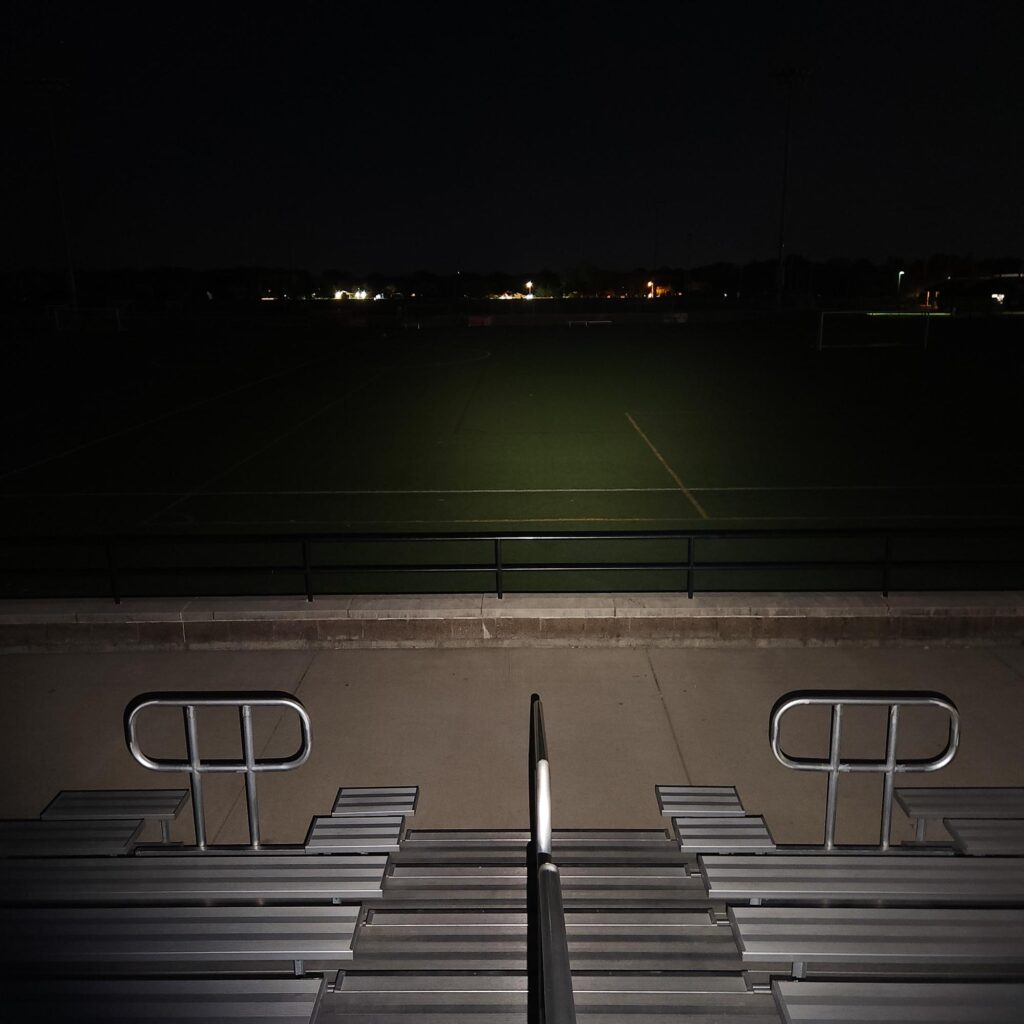
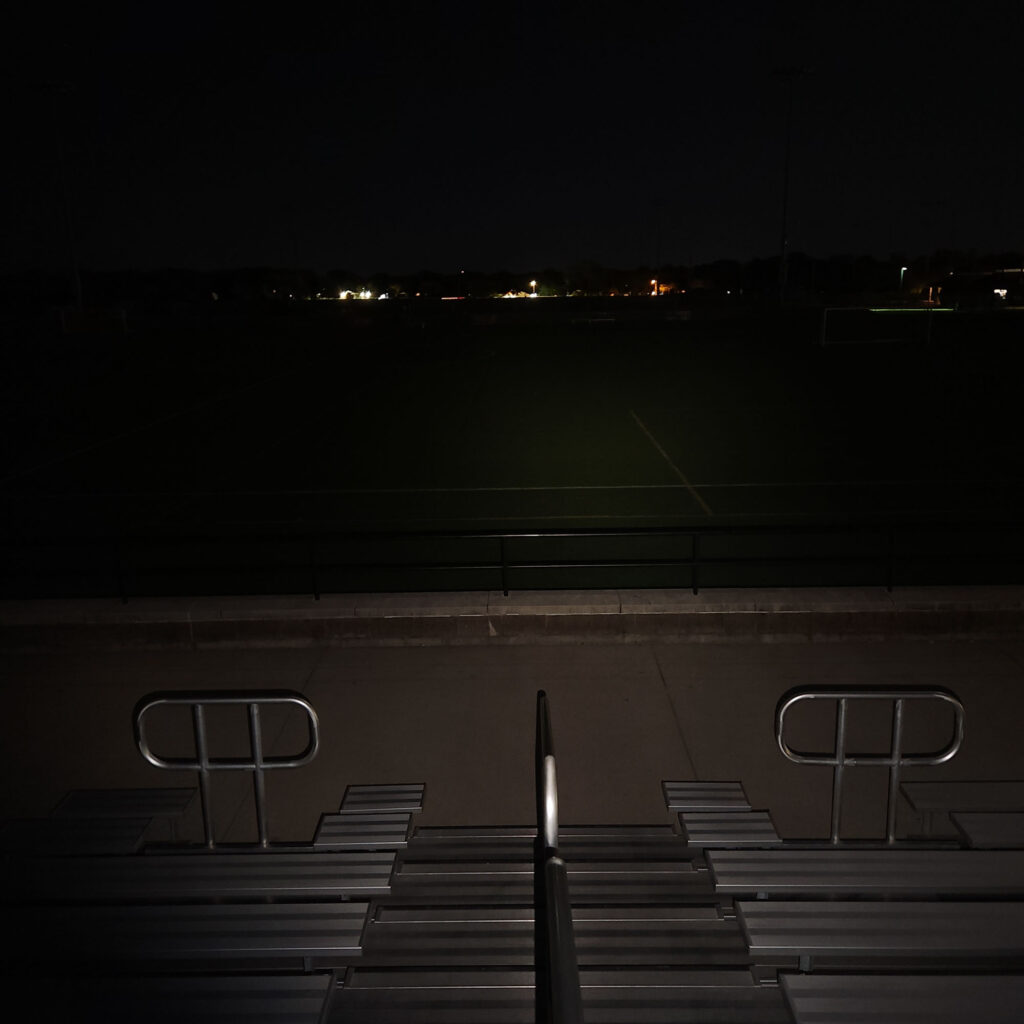
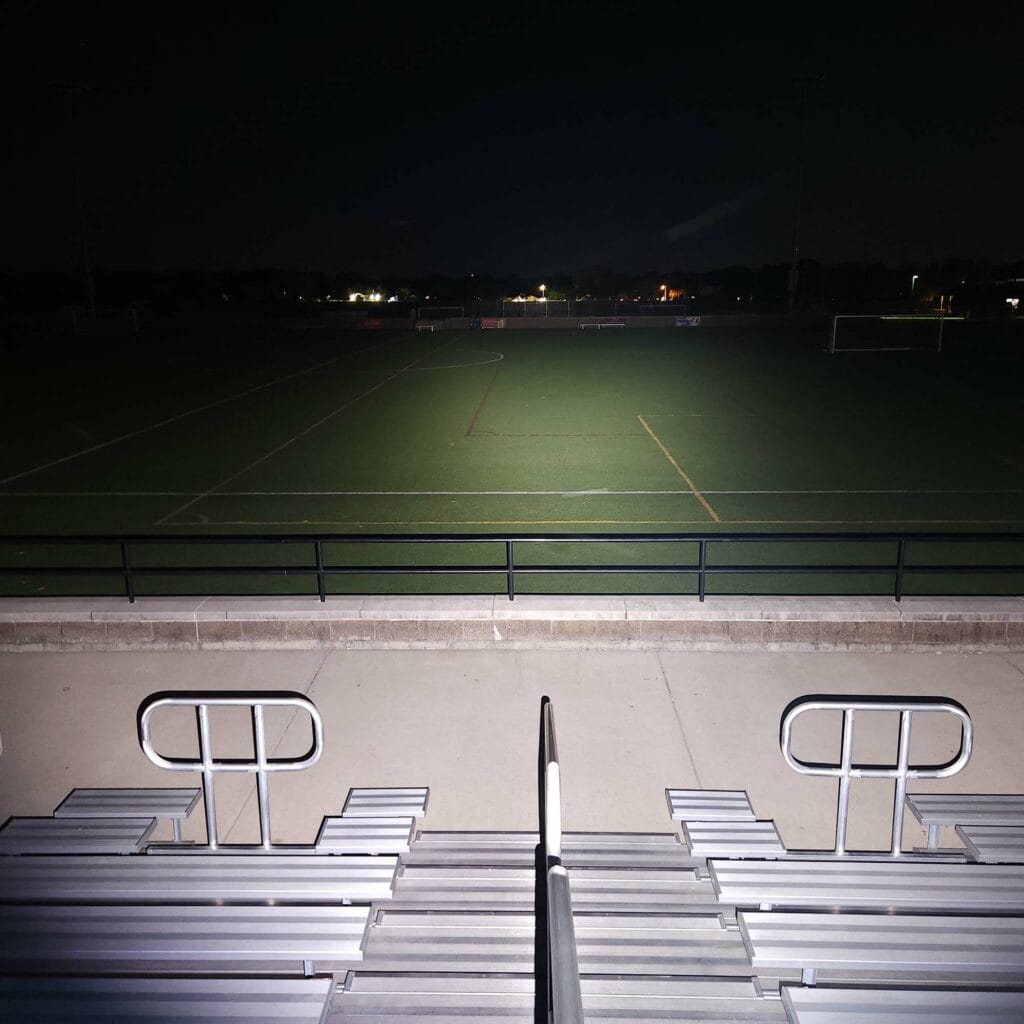
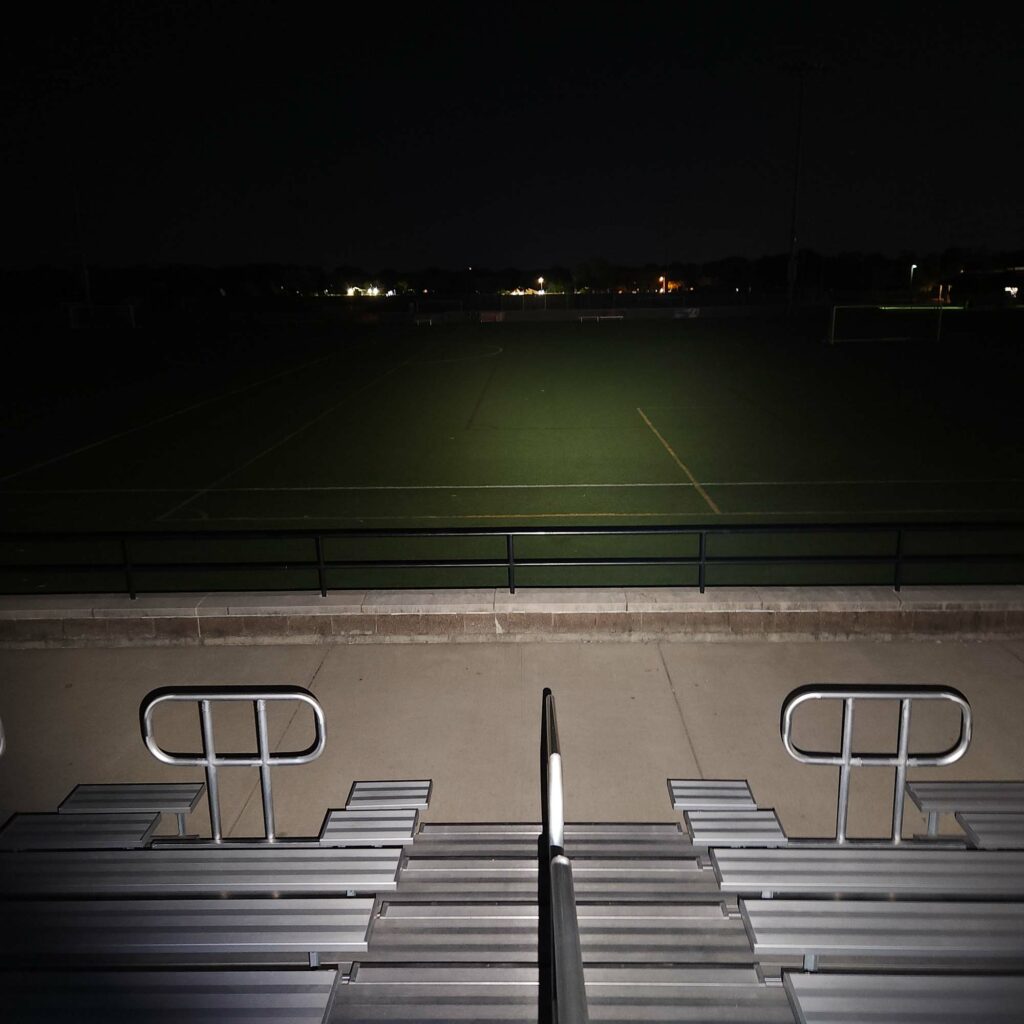
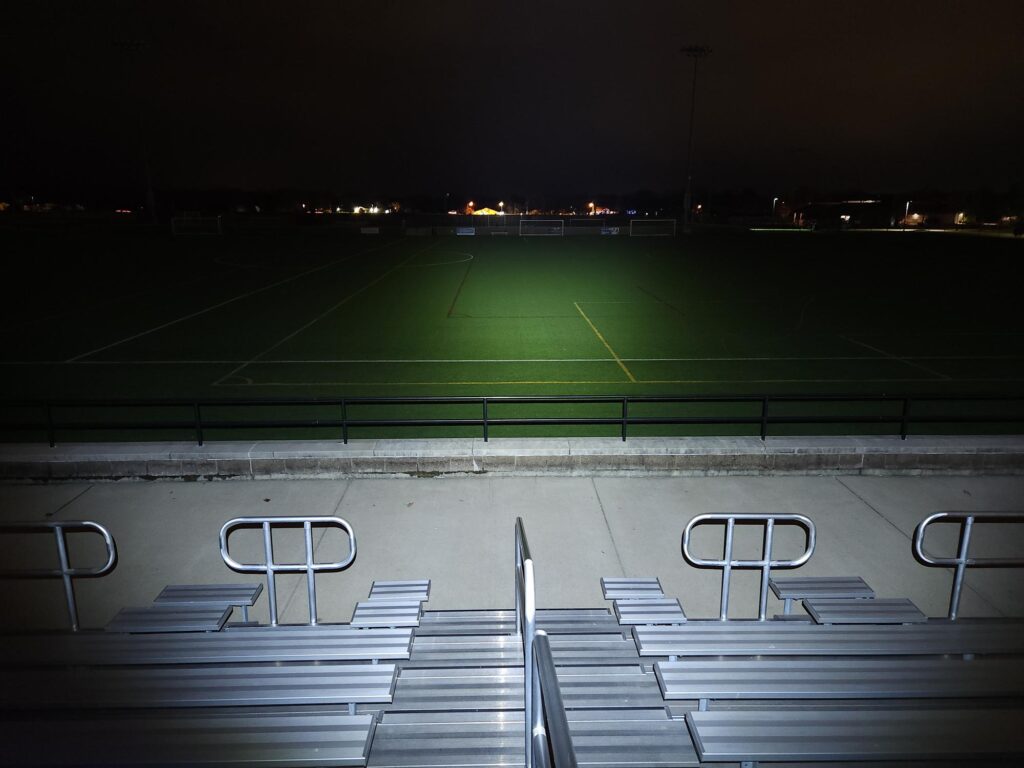
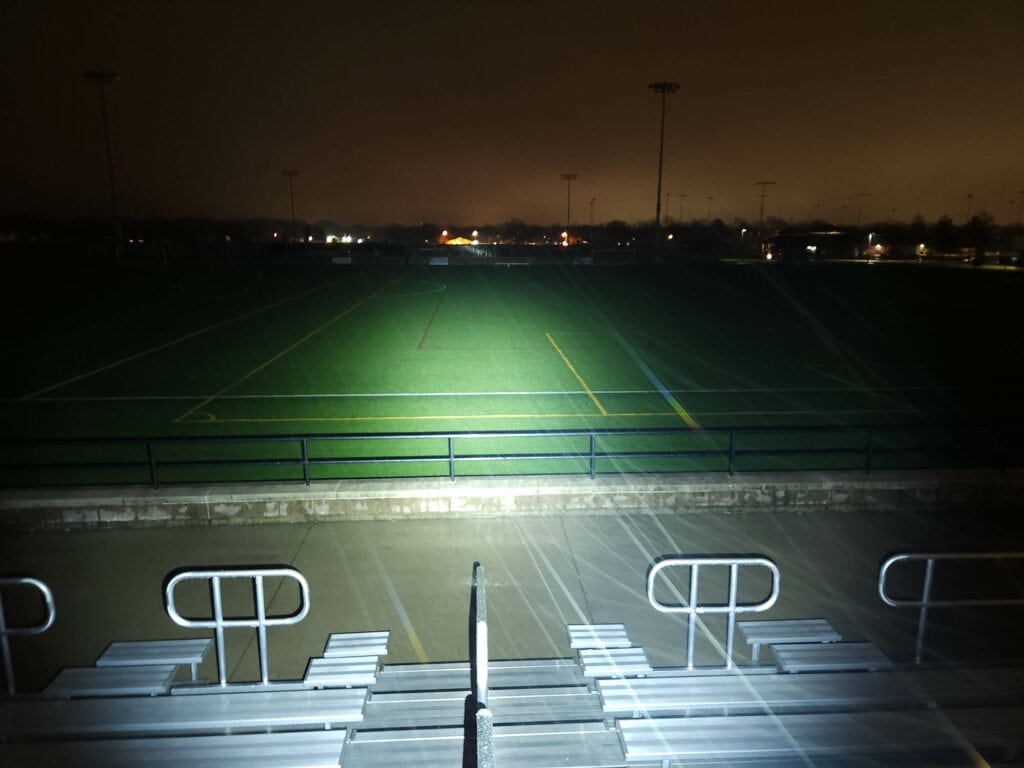
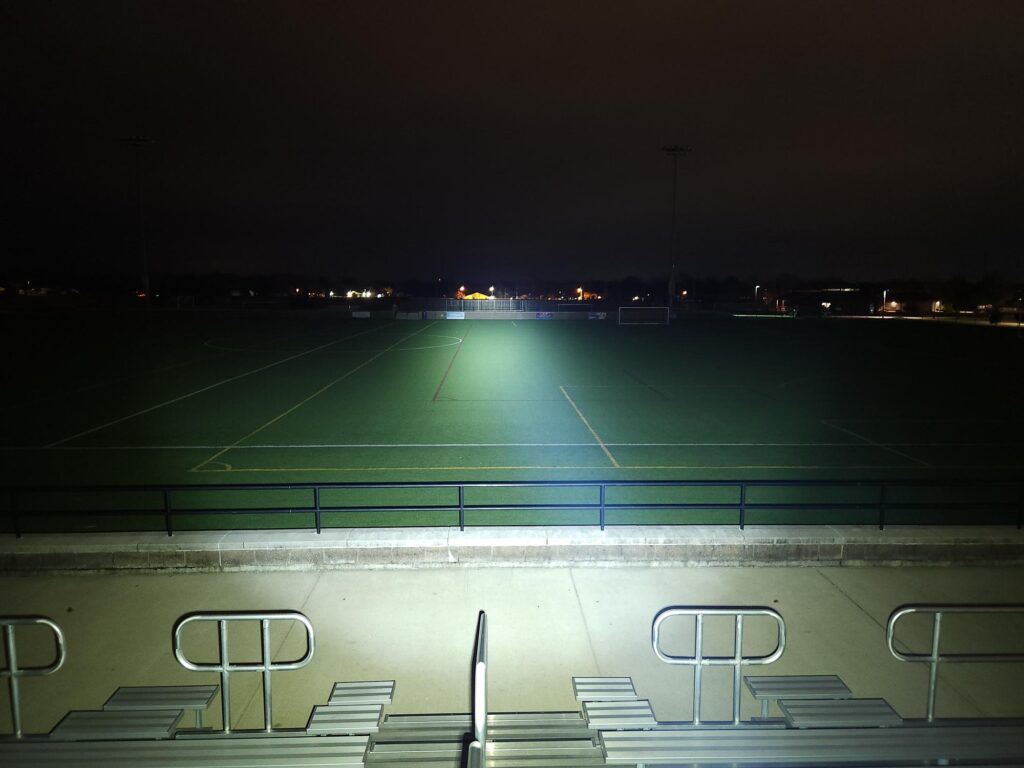
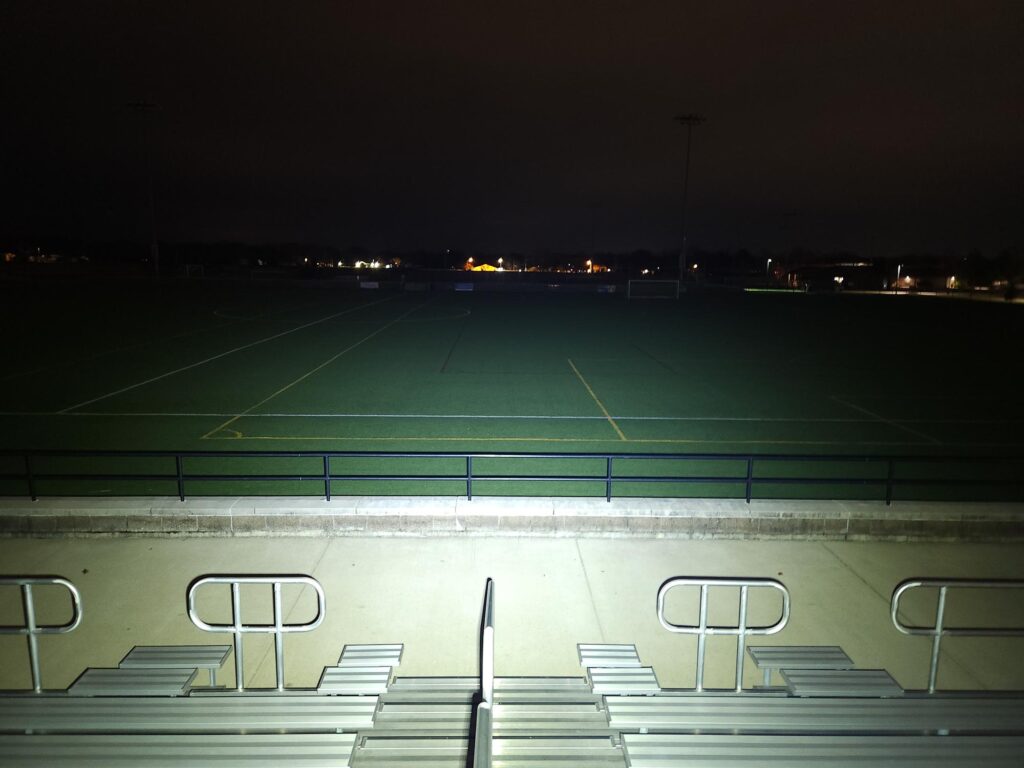
Disclaimer: This flashlight was sent to me for review at no cost by Skilhunt. I have not been paid to review, nor have I been holding back on problems or defects.
Final Verdict
Pros
- Lots of emitter choices, including high CRI
- Complete package with USB charging and battery
- Familiar UI of M200 v3 and M150 v3
Cons
- Proprietary charger
- Skilhunt battery on the expensive side
Explanation on star ratings:
1: Avoid: a match would be a better choice – 2: Poor: significant defect or issues; almost unusable – 3: Average: some defects or issues; but still usable 4: Good: recommended (minor issues) – 5: Great: highly recommended

5 stars: ★★★★★
While our star rating provides a reliable indicator, we encourage you to read the full review to make an informed decision based on your own needs and preferences.
Skilhunt’s M-series of lights is the most closely related group of flashlights I know, having both the same design and same UI: The M150 v3 for pocket carry, the M200 v3 for all-around EDC, and now v2 of the M300 for higher power and extended use.
With the different emitter choices that v2 has, you can configure it to either be brighter and throw farther, or have nice, high CRI light, so it fits a number of use cases. Maybe you even need two of them!
Skilhunt also uses proprietary magnetic charging, which I think is ok, even if others dislike it. Just keep in mind that if you only have one charging cable and you lose it, you’ll have to find another way to charge.
Overall, I give the Skilhunt M300 v2 five stars.
Buy your Skilhunt M300 v2 with a discount
Get 6% discount at Skilhunt by using the following discount code: blf06
1lumen selects and reviews products personally. We may earn affiliate commissions through our links, which help support our testing.